In this article, we’ll cover all the best things to do in Petra. We’ll discuss the top attractions in Petra as well as some of the hidden gems in the ancient city of Petra. We’ll also cover the best hiking trails in Petra and more.
Petra is one of the most beautiful places in Jordan. It’s one of the Seven Wonders of the Modern World and a UNESCO World Heritage Site. It’s well worth exploring fully. Although that may take a lifetime!
With so much history, it’s no wonder there are some incredible things to do in Petra. From seeing some of the highlights of the Ancient City to the hidden gems that are off the beaten path, we want to cover what to do in Petra, regardless if you go for 1, 2 or 3 days.
We have a full guide to Petra here, but we wanted to help you see all the best attractions in the Ancient City. If you’re missing any information here, make sure to check out our other article for a more comprehensive guide.
So without further ado, let’s jump into the best things to do in Petra.
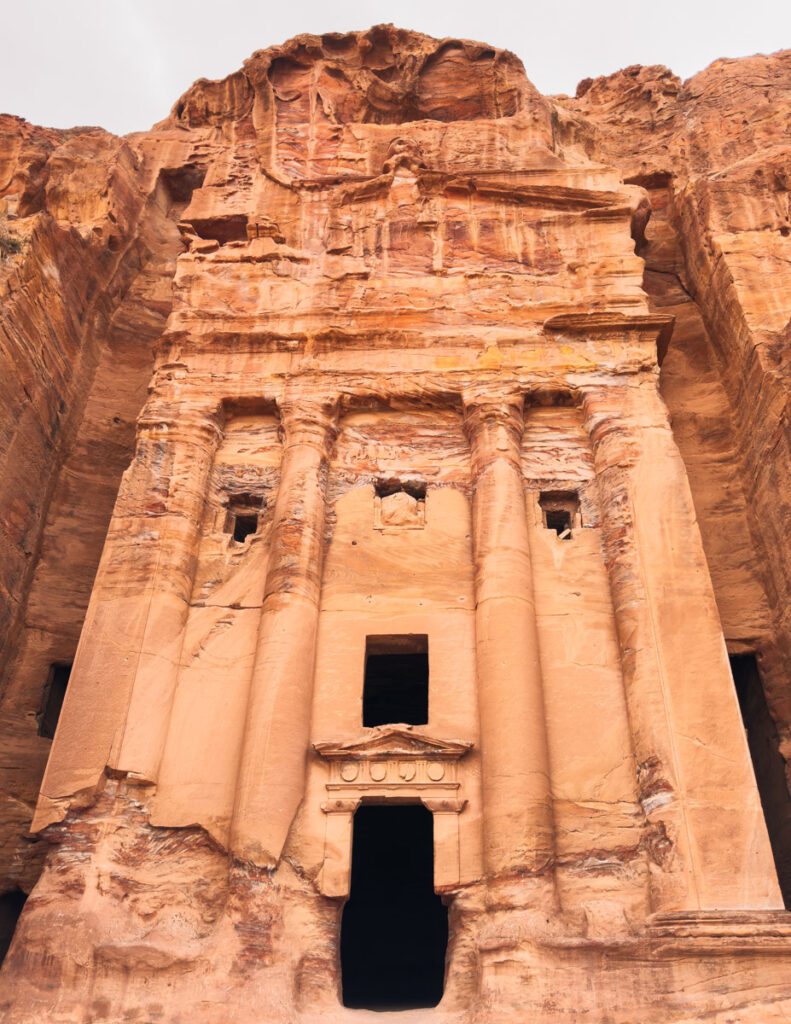
This article may contain affiliate/compensated links. For more information, please see our disclaimer here. We take all the efforts necessary to ensure the information included in this post is accurate, correct and current, sometimes, things just change! Travel information like opening hours, business operations and prices may change. If you find anything in this post that is incorrect or outdated, please let me know in the comments so I can update it for other readers. Cheers!
We love helping you plan amazing trips. If you need any of these services, consider booking them through our affiliate links. Without costing you anything extra, you will be helping support us so we can continue to write these blogs for you.
We thank you again for your continued support.
🏠 Find the perfect place to stay with Booking.com
✈️ Get the cheapest flights with Skyscanner
🚣 Book your favorite activities with Viator
💻 Make sure you have everything you need for your epic trip by checking our store on Amazon
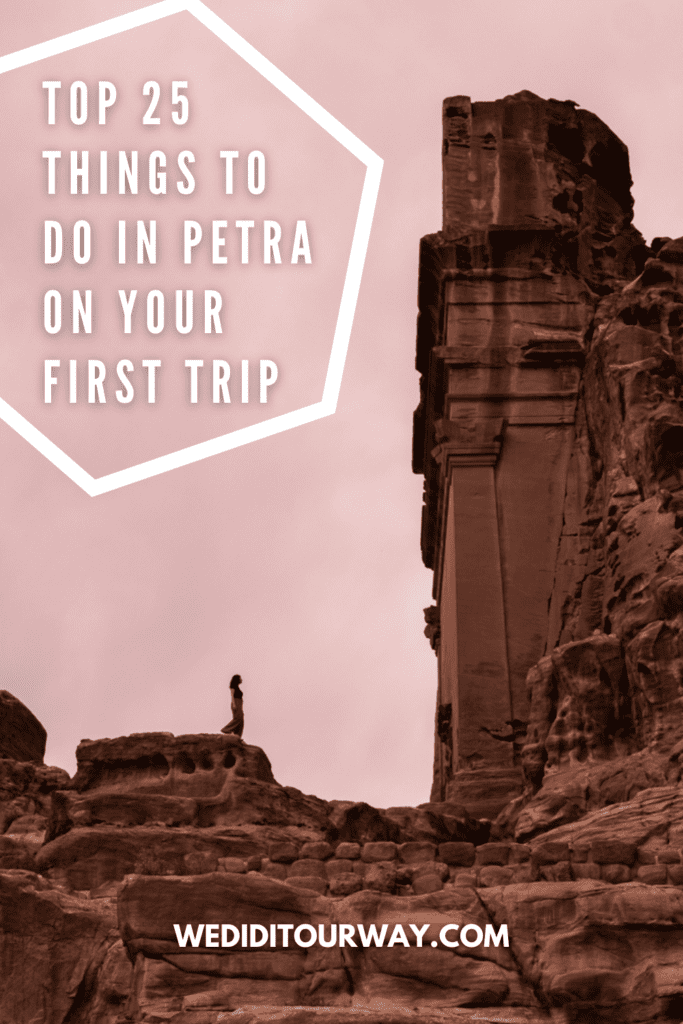
Table of Contents
Map of the best things to do in Petra
In order to get a full understanding of the size of Petra, here is a quick map that shows where everything is located.
When we say Petra is huge, this is what we mean. Although some of the sites are close together, some of the hidden gems are truly hidden and off-the-beaten-path.
This map will help you better plan how you want to spend your days in Petra.
The 10 top attractions in the Ancient City of Petra
In this first part, we’ll look at the highlights in Petra. If you have limited time here, like 1 day only, these are the sites you should be exploring.
The Ancient City of Petra is spread over 264 square kilometers, that’s roughly 50,000 football fields. This is why you need more than a day in Petra. Depending on how long your Jordan itinerary is, you can see how much you can explore.
It’s important to know that there’s much more to Petra than just the Treasury. That’s why we want to share with you all the best things to see in Petra.
So get ready to walk a lot (and read a lot) as there are plenty of sights in Petra that are worth visiting. Depending on how many days you have, and how keen you are on walking, you can determine your itinerary and what you can see.
In this list, we’ll start with the most important and impressive structures and go down the list.
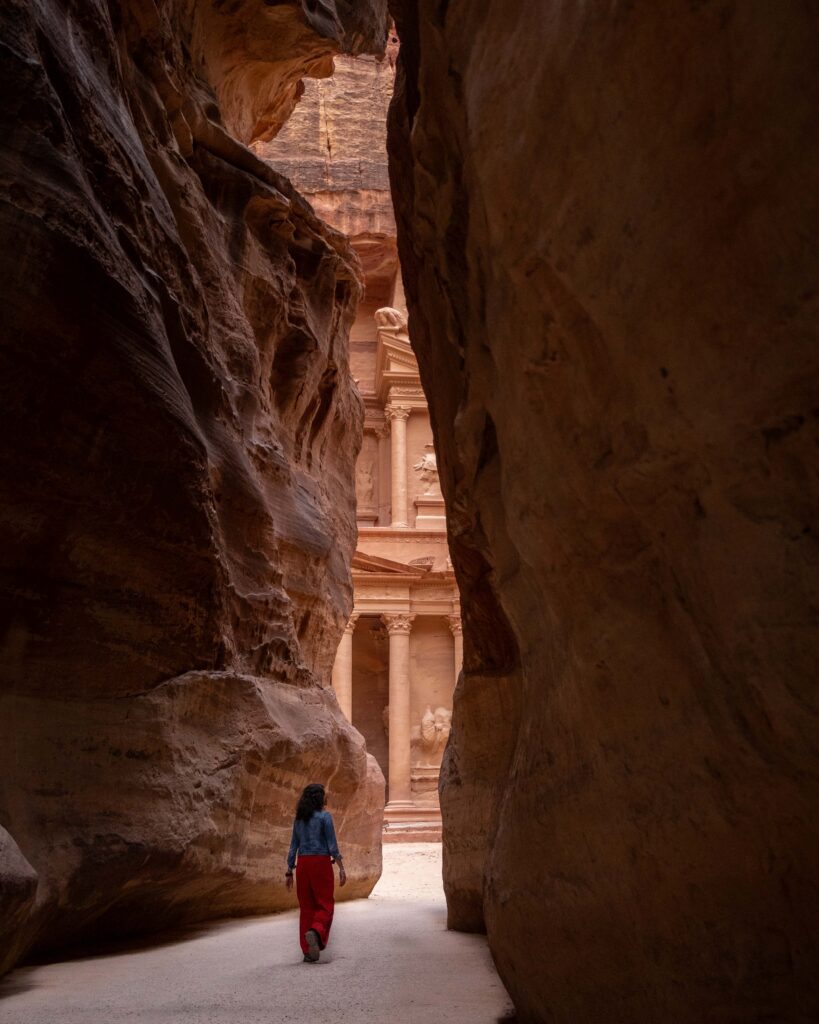
1. Discover the Treasury, the top thing to do in Petra
It’s no surprise that the Treasury is the most iconic structure in Petra. We’ve all seen tons of pictures and videos of it all over social media, in magazines and on TV.
The Treasury was made famous by being featured in the Indiana Jones movie, where it was said the Holy Grail was stashed.
Built around the 1st century BCE to the 1st century CE, the Treasury is really impressive to admire from all angles. We highly recommend spending time checking out the intricate details of this structure.
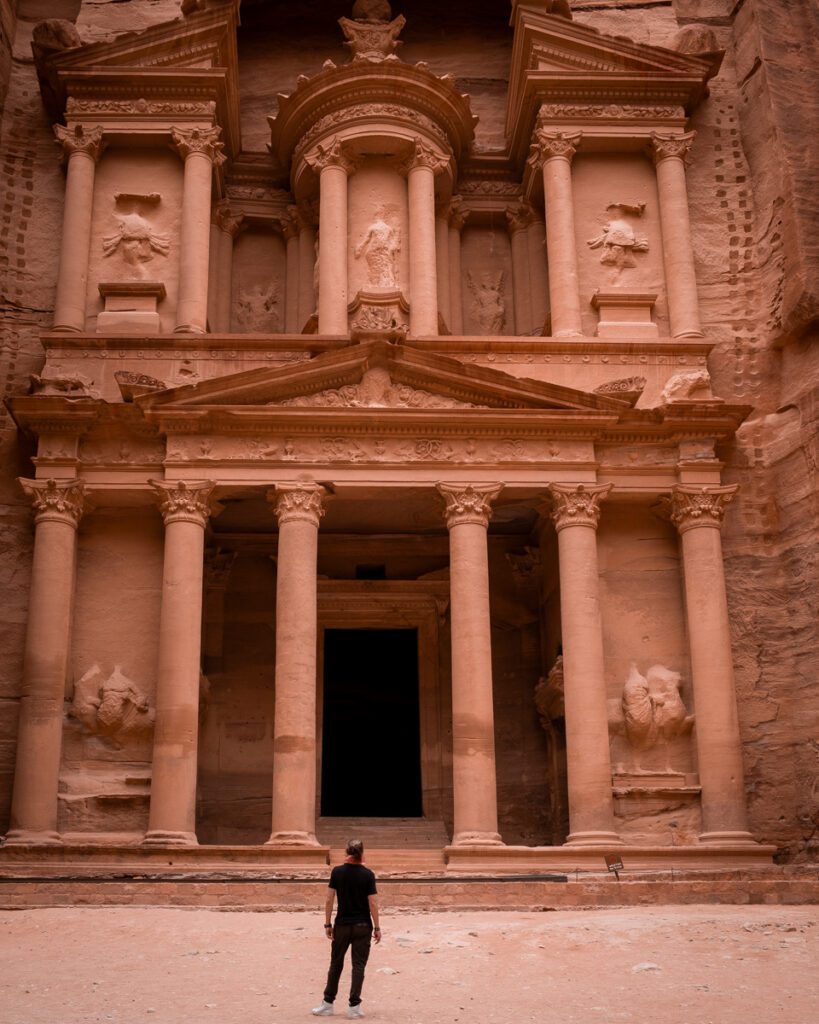
Al-Khazneh, or The Treasury, is considered to be Petra’s most beautiful facade. It stretches about 40 meters high, taking up most of the rock facade of the surrounding cliffs.
The facade is so intricately carved with details that have stood the test of time. At the top, the Treasury is crowned by a funerary urn. According to local legend, it conceals a pharaoh’s treasure. this is why you can see bullet marks on it. People have tried to get the treasure.
The Treasury is not the first structure you’ll see in the Ancient City of Petra. But the way it pops up out of nowhere through the Siq is really impressive and adds to its mystisism.
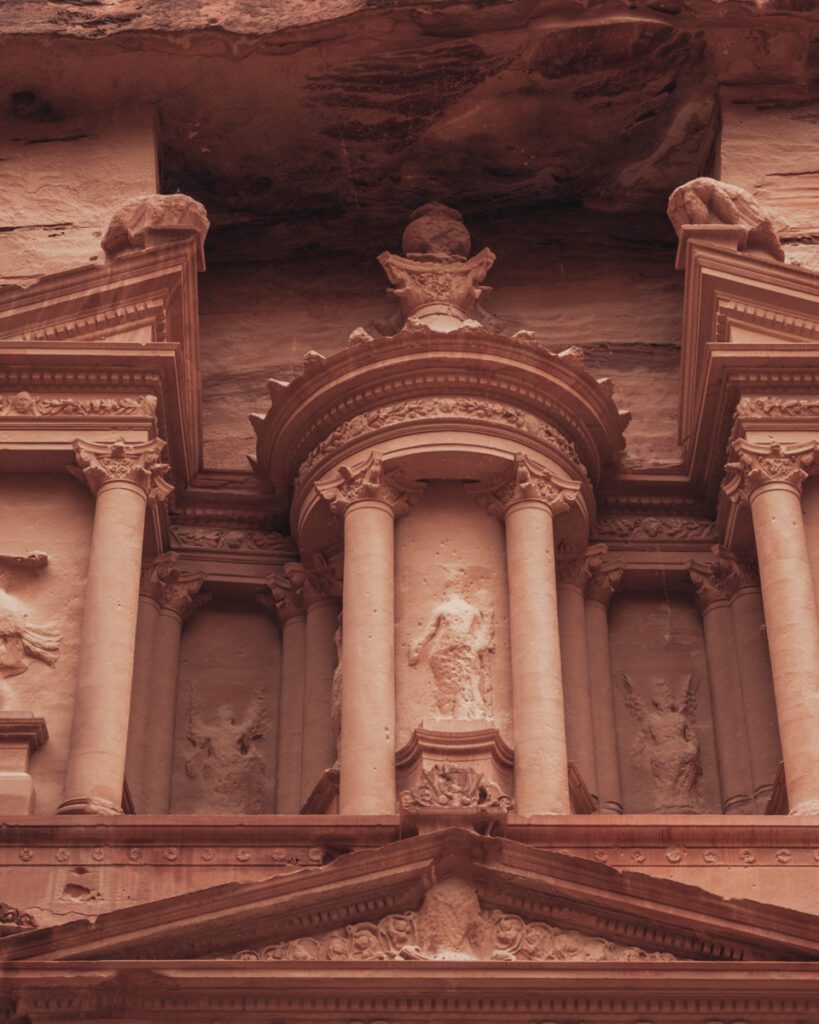
Although its name, “the Treasury,” stems from a local legend about the hidden treasures within it, its exact purpose is still a mystery. The most agreed-upon theories say it was probably a royal tomb, a temple or an actual treasury…
The Treasury is located a 30-minute walk from the main entrance of the Petra Visitor Center. The ground is pretty flat with no elevation gain. And the route is paved in some parts.
If you don’t want to walk to the Treasury, you can take an electric golf cart or take a horse. We don’t recommend any of these options unless you are truly unable to walk there.
2. Journey through the Siq, Petra’s narrow canyon
Between the Visitor Center, the Dam and the Treasury, you have one of the top attractions in Petra, the Siq. The Siq is the narrow canyon that leads you to the Treasury. It’s the main gate to the Ancient City of Petra.
The Siq was created by the natural splitting of the mountain. Carved over thousands of years by the erosive forces of water, wind, and time, the Siq served as a natural geological fault line, gradually widening and deepening to form the canyon we see today.
It’s an impressive route winding through the towering 200-meter tall cliffs, often changing in color and shape.
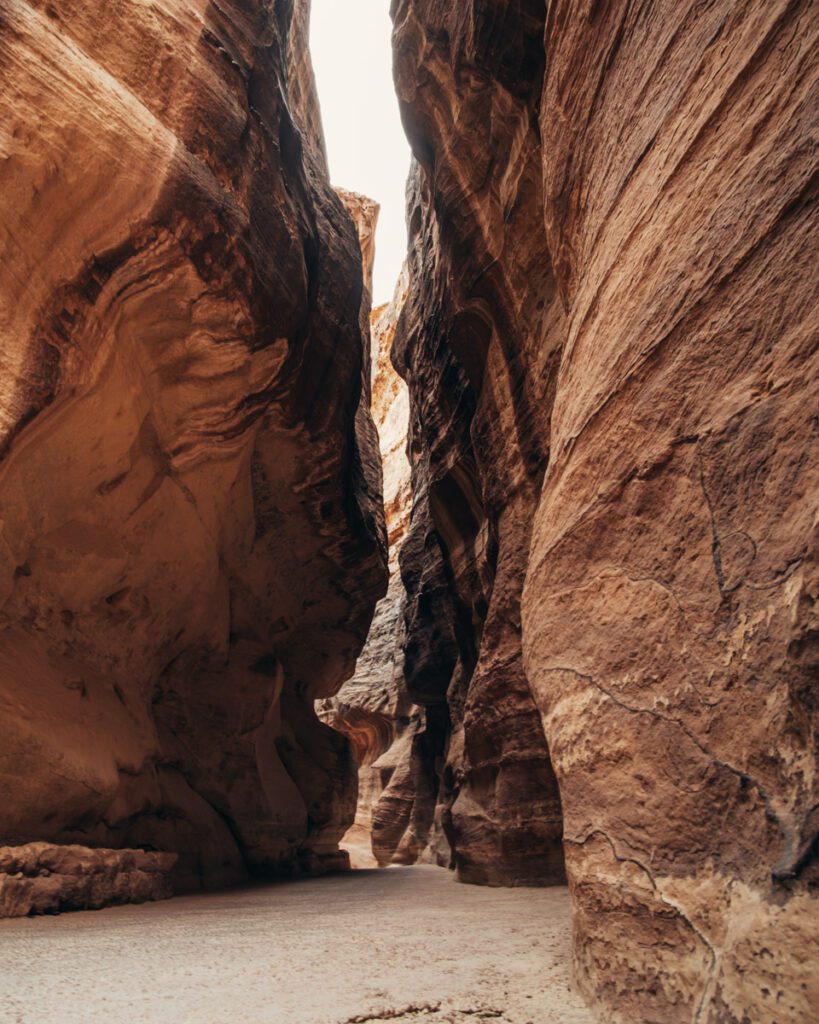
You may be wondering why this is an important attraction in Petra, and there are many reasons for it.
Beyond its sheer magnitude, you’ll notice that along the sides of the Siq, there are water channels. These were used by the Nabateans to divert water from the site. They are also said to be remnants of their aqueduct system. The Nabateans were known to be masters in hydrological engineering.
Along the sides of the Siq, you’ll notice niches, alcoves, and carvings in the rock walls. This is further evidence of the Nabateans’ skills in carving and manipulating their surroundings.
One of the most remarkable carvings is located at Sabinos Alexandros station. This is where you can see a set of baetyls and stone carvings. They were carved by Sabinos, a master of religious ceremonies and dedicated to the Nabatean deity, Dushara.
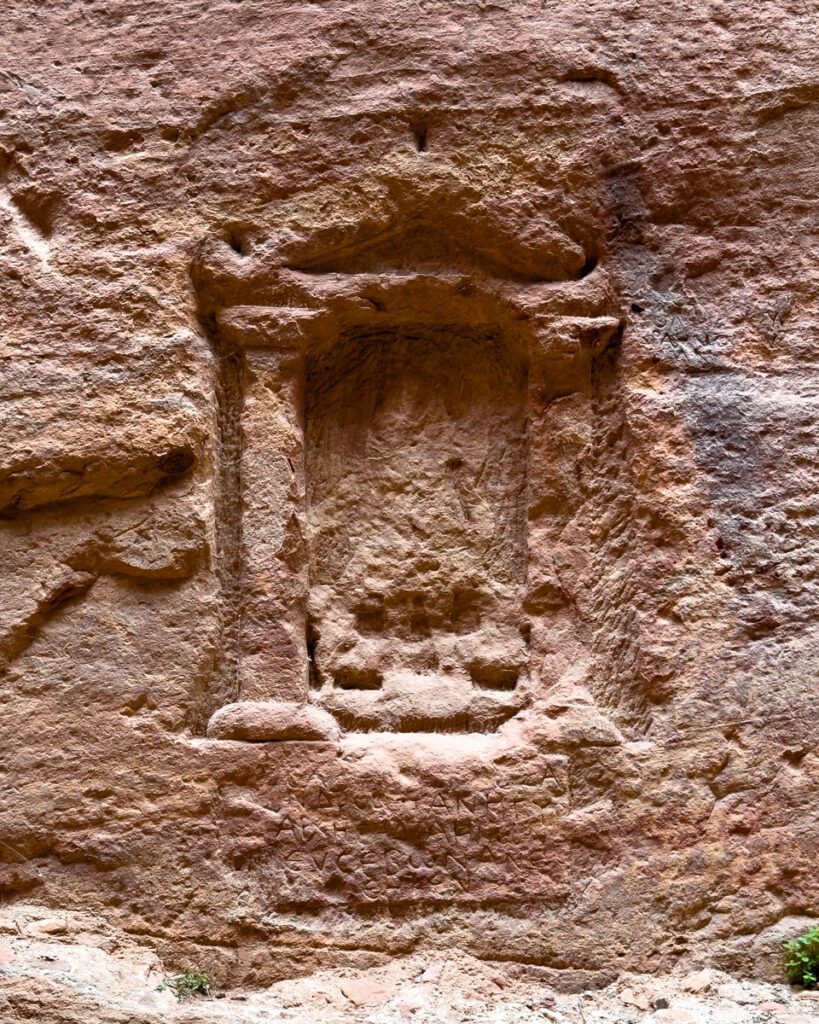
Stretching over 1.2 kilometers, the walk through the Siq is only about 10-15 minutes. The surface is flat and well-paved.
There are 2 ways to get through the Siq, the first is to walk. It’s the way we recommend. You can hear birds chipping and the echoes of people talking. It’s really a lovely experience. Plus the Treasury reveal is just magical.
If not, you can rent an electric golf cart. These cost 15 JOD one way and 25 JOD for a return trip.
The reason we don’t recommend this mode of transport, unless you’re unable to walk, is because despite being electric, they are extremely loud. They ruin the experience for people around.
Once, you pass through the Siq, you will reach the Treasury and the rest of Petra’s top attractions.
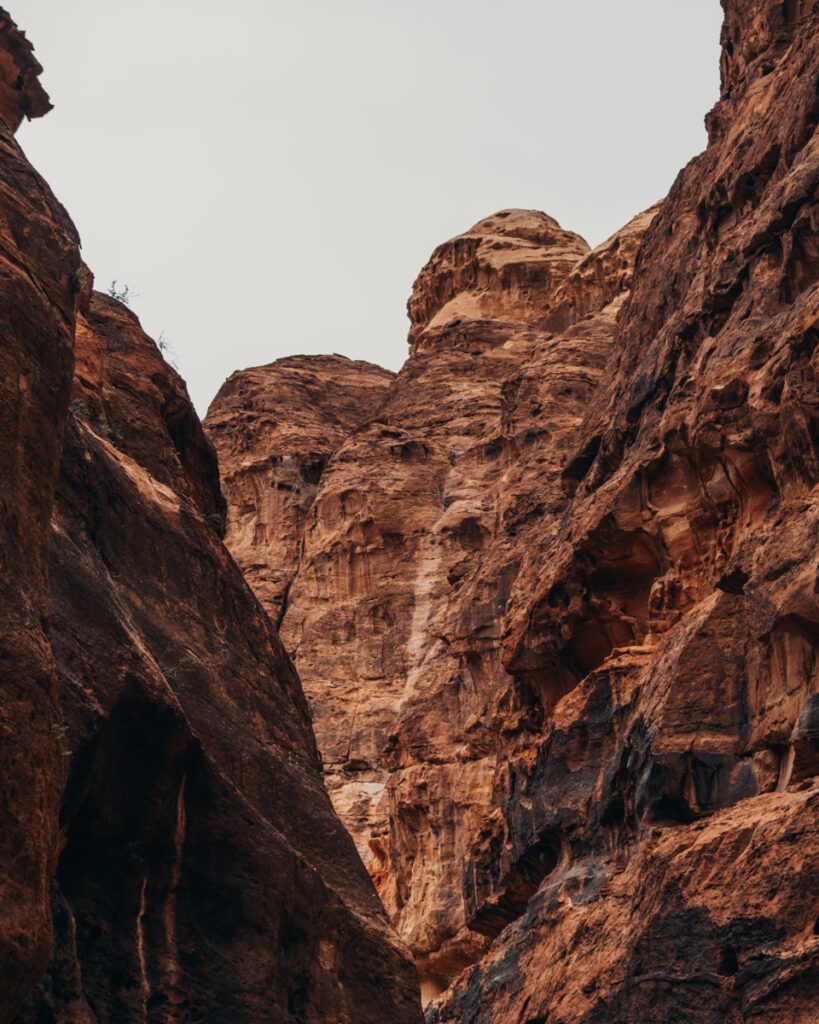
3. The Monastery, Petra’s attraction that is hard to get to, but beautiful to admire
The Monastery, or Ad Deir, is one of the harder sites to get to within the main part of Petra. For hikers and those who don’t mind a challenge, it’s one of the best things to do in Petra!
The Monastery is located high on the cliffs overlooking Petra. It has a similar design to the Treasury but it’s much larger in scale. In fact, the Monastery is one of the largest monuments in Petra. It’s 47 meters wide and 48 meters high.
On its massive facade, you can see columns, statues, and intricate reliefs.
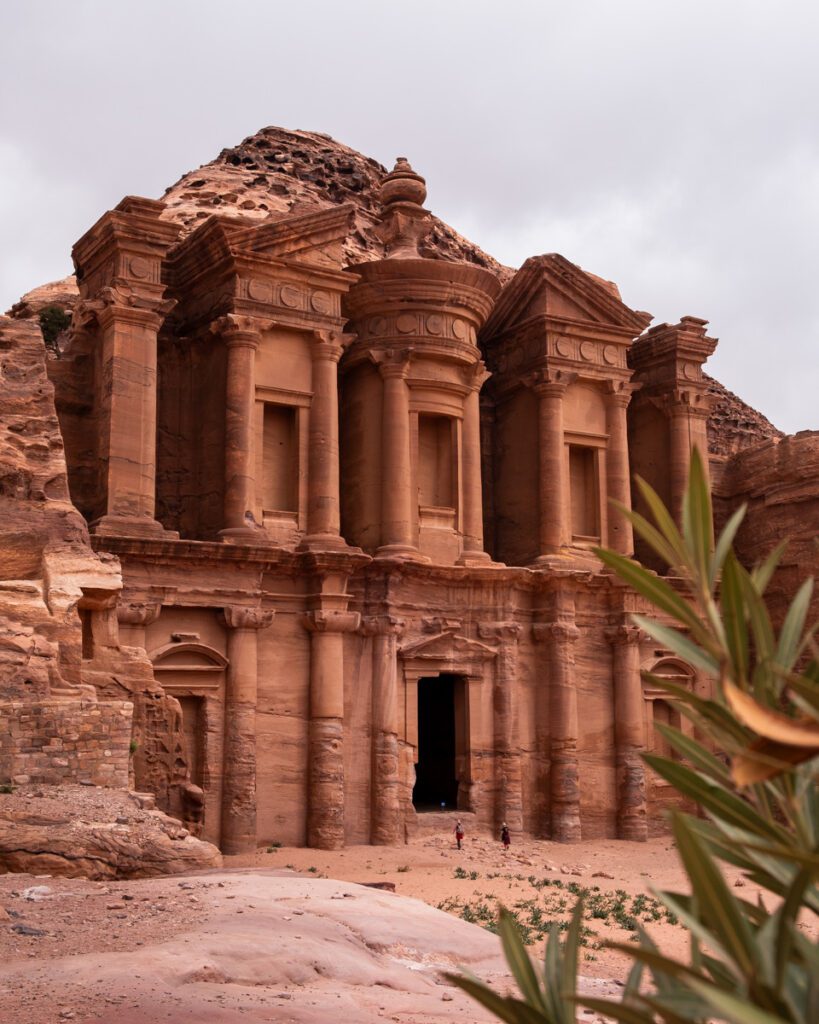
The Monastery was said to be built in the 2nd century CE. Its exact purpose is still debated by historians and archaeologists. While its name suggests a religious function, some theories suggest that it may have served as a temple, a royal tomb, or a meeting place for religious ceremonies and rituals.
Later, the Monastery was used by Christians as a chapel. Some crosses are carved into the rear wall of the main hall, which is where the structure got its name.
How to get to the Monastery from the main entrance
There are 2 ways to get to the Monastery. You can get here from Petra’s Visitor Center, or from the back way starting at Little Petra.
From the Main gate, you have to walk the 8 km (5 miles) long main trail and will take between 1.5-2 hours until you reach the foot of the stairs leading up to the Monastery. You will walk past all the highlights of Petra along the way.
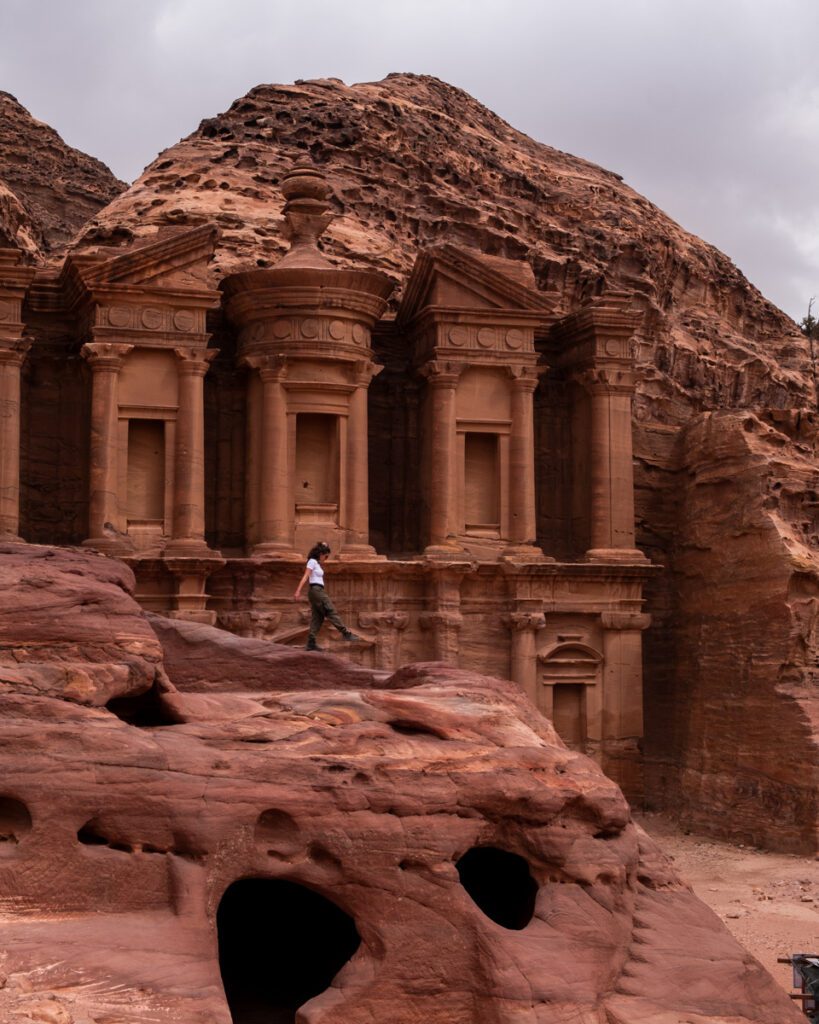
From there, you’ll have to climb up hundreds of steps to get to the Monastery. This route will take anywhere from 1.5-2 hours before reaching the site. Once you reach the Monastery, you’ll have to walk all the way back down the stairs and through the site again.
The whole journey can take anywhere from 6 to 7 hours total, including your way there and back. It’s about 10.5 km long, or 6.6 miles.
The negative part about this hike is that you’ll have to double back once you reach the Monastery and hike the same route in the opposite direction.
How to get to the Monastery from the Back Way
Alternatively, you can walk the back way to get to the Monastery. We’ll get a little deeper into this option further on in this article.
If you’re interested in hiking the Back Way, we’re preparing a dedicated article for you here.
This is the route we chose and absolutely loved the experience. If you want to get off the beaten path in Petra, we highly recommend it!
To walk this route, you can take the free shuttle to Little Petra. It departs from the back of the Museum every 30 minutes from 7:30 am to 2 pm. It takes you to the entrance at Little Petra.
After exploring the site, you have 2 options. You can take another Jeep (5 JOD per person) to the back stairs. Or, you can do as we did and hike the full route. The Jeep ride cuts about 1-1.5 hours of hiking from the journey.
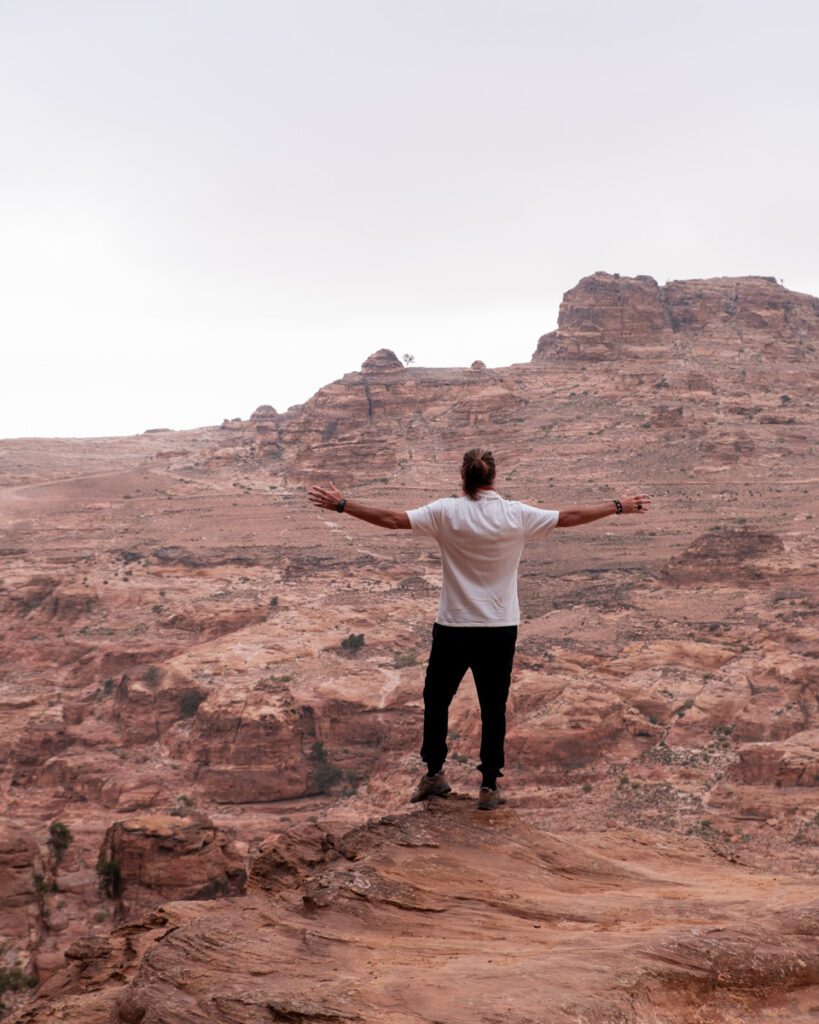
The hike the full way will take about 2.5 to 3 hours, depending on the stops you make. The views are insane so we recommend taking your time. If you take the Jeep, you’ll need about 1-1.5 hours to reach the Monastery.
Beyond the breathtaking views of the area, we found this route to be more efficient and a better way to explore more of Petra. You don’t need to rewalk the Petra site once you reach the Monastery. You don’t need to climb the stairs to the site either. Instead, you’ll be heading down them.
4. The Street of Facades, an impressive attraction in Petra
This is one of the most impressive sights in Petra, mainly because of how far it goes!
You’ll reach the Street of Facades after seeing the Treasury. These elaborately decorated facades are adorned with intricate carvings, columns, and reliefs.
Stretching approximately 350 meters (1,148 feet) in length, the Street of Facades is a stunning array of monumental tombs and burial chambers that were carved into the cliffs.
Seeing so many of them makes this site quite incredible. Plus, if you can, we recommend hiking to the top facades to get an impressive view of the site, and to explore some of these tombs more closely.
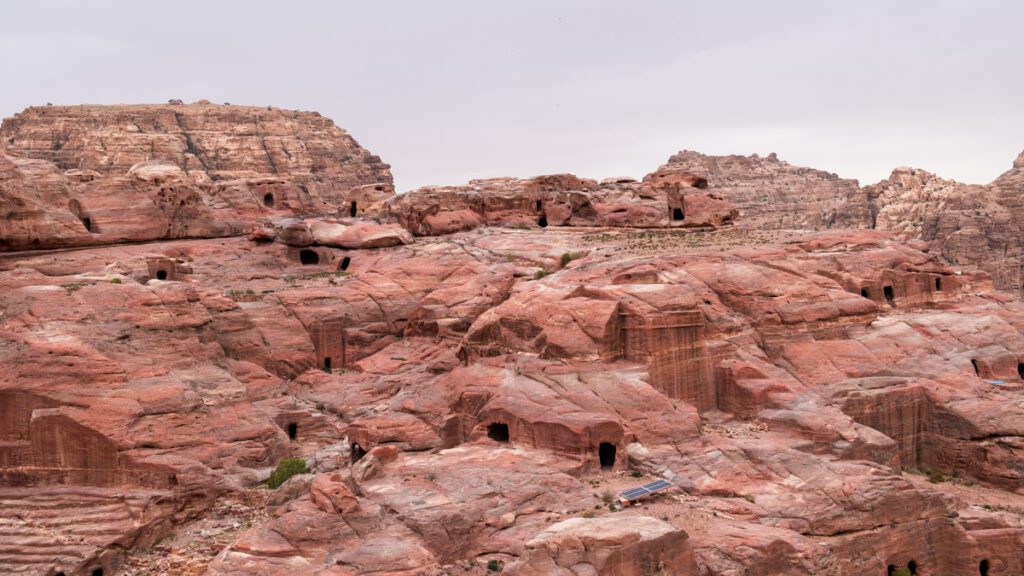
The tombs along the Street of Facades served as final resting places for the Nabatean elite – rulers, nobles, and wealthy merchants. The more ornate the tomb, the more important the person who occupied it.
Despite its name, the Street of Facades is more than just a collection of tombs. Along the thoroughfare, visitors can also find evidence of ancient Nabatean dwellings, shops, and workshops, providing insights into daily life and commercial activities in Petra.
What many people don’t know is that some of these chambers were later used as homes by inhabitants of the Rose City. Some of these ancient dwellings feature doorways and niches. There are other modifications that provide insight into how Petra’s urban landscape evolved over the centuries as well.
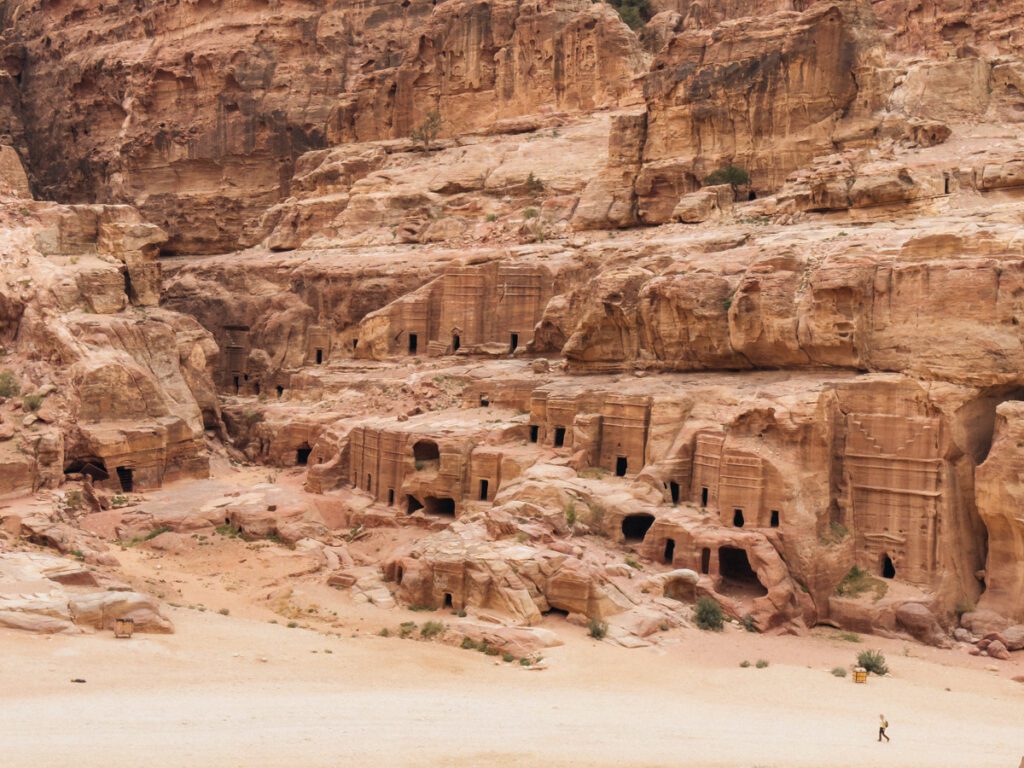
5. Discover the intricately designed Royal Tombs, one of the best things to do in Petra
If you were impressed by the Street of Facades, get ready to discover the beauty of the Royal Tombs. They’re stunning and so grandiose!
Located next to the Street of Facades, above the rest of the site, you have a series of Royal Tombs. They are a group of four facades, one next to another. As the name states, they are the final resting place of Nabatean royalty and society’s elite.
The Royal Tombs are located high on the cliffs. They overlook the central city area. From here you have a spectacular view of the surrounding area. You can see the Street of Facades, the Colonnaded Street, the Amphitheater and so much more!
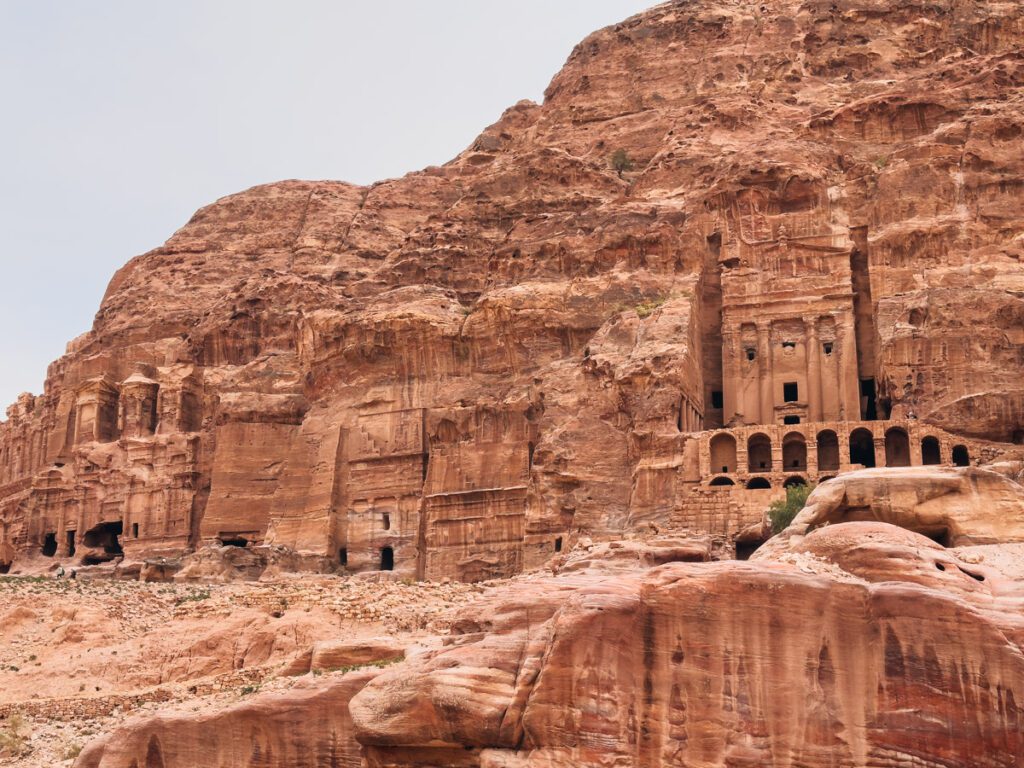
The Royal Tombs stand out because of their grand scale, elaborate facades and intricate architectural details. You can see a blend of different styles, including Nabatean, Hellenistic, and Roman. They truly are beautiful and each one is unique.
The 4 main tombs are the Urn Tomb, the Silk Tomb, the Corinthian Tomb and the Palace Tomb. Each served a different purpose at different points in time.
It’s well worth getting an up-close look at the Royal Tombs. You can reach them from the Street of Facades, or walk the path that leads to them from the main Petra street.
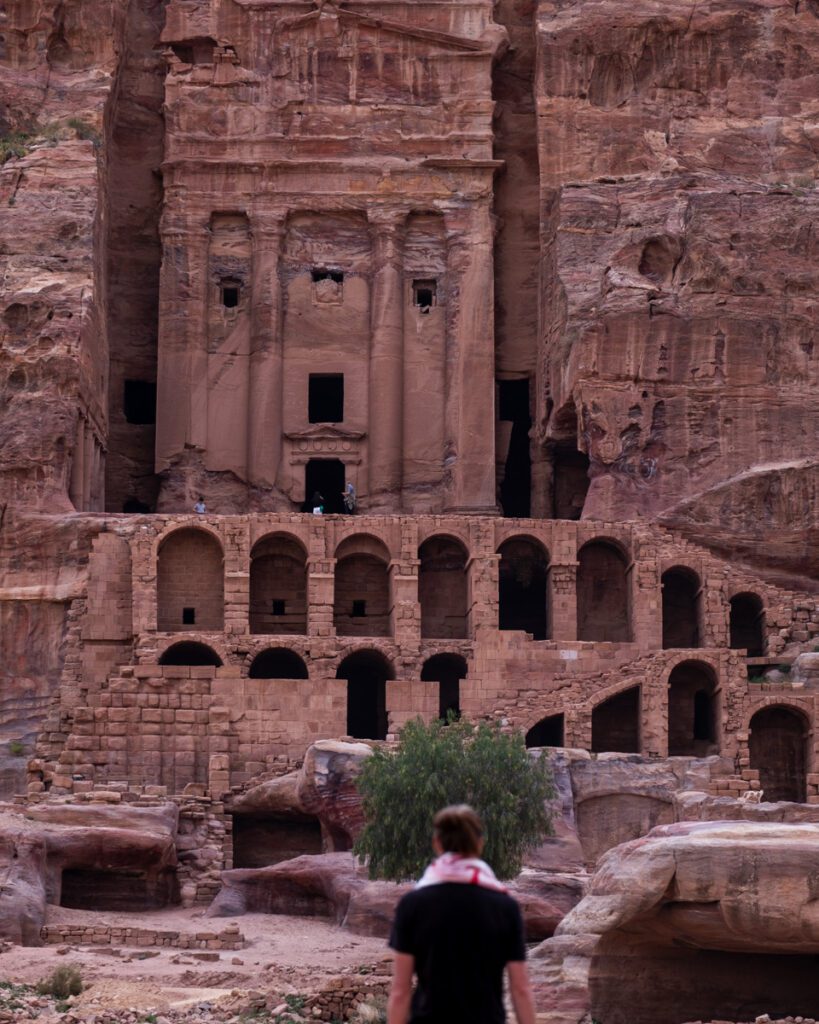
The Urn Tomb
The Urn Tomb is also known as Al-Khazneh al-Firaun. It is thought to have been built in 70 CE.
The urn-shaped funerary chamber located inside is how it got its name. The Urn Tomb is one of the largest and most ornate tombs in Petra. It was probably our favorite one considering how beautiful it was. Spread over many levels, it was a great place to explore.
It has a towering facade that features columns, pediments, and a central doorway leading into the burial chamber. The intricate design elements suggest that it was intended to honor an important person within Nabatean society.
It is believed that the surrounding chambers and niches may have contained offerings, funerary goods, or additional burials. Some thought that there were treasures buried here, but no such evidence has been found.
In 446 CE, it was converted to a Byzantine church, proof of all the different civilizations that lived in Petra.
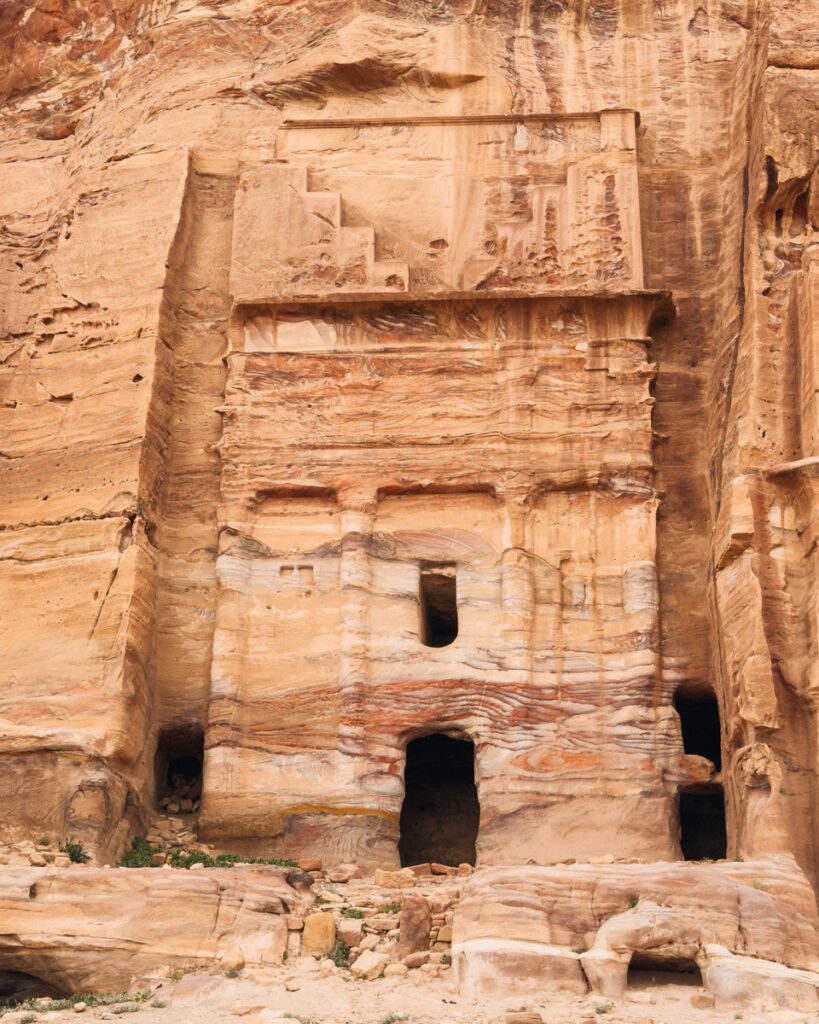
The Silk Tomb
The Silk Tomb (Al-Khazneh al-Hayat) is named for the vibrant colors of its sandstone facade. It has so many swirls of colors – it’s truly impressive. Its striated patterns and hues of pink, orange, red and purple are what make the Silk Tomb so special.
Despite its name, the Silk Tomb was likely a royal burial chamber rather than a textile workshop. Again, it was probably the burial tomb for a wealthy Nabatean.
Make sure you stop and take a close look when you’re exploring the other Royal Tombs. The different colored-swirls really make this tomb unique.
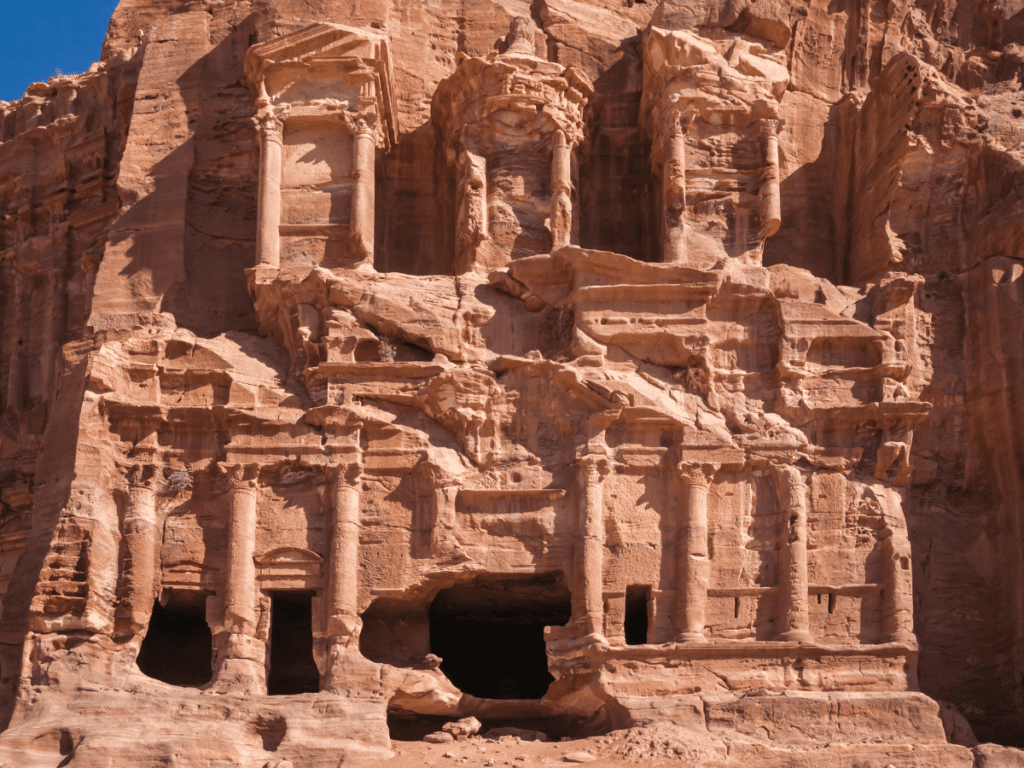
The Corinthian Tomb
The Corinthian Tomb (Qasr al-Bint al-Pharaun) may look familiar. It draws a lot of inspiration from classical Greek and Roman architectural styles. And, it looks a lot like the Treasury.
The name “Corinthian Tomb” refers to the architectural style of its columns characterized by elaborate decorations. This style was popular in ancient Greece and Rome, becoming a hallmark of classical architecture.
With time, it has been severely eroded, but you can still imagine its beauty. It is believed to have been the tomb of a Nabatean king or queen. Beyond this, its imposing presence and commanding location suggest that it held significant cultural and religious importance for the Nabateans.
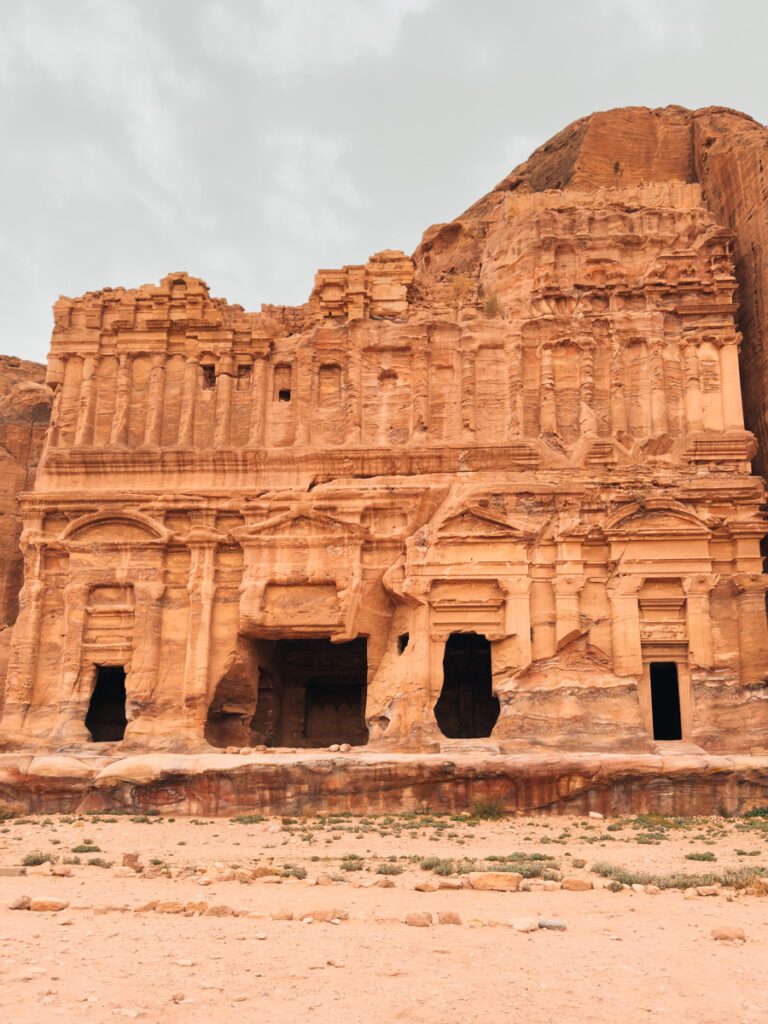
The Palace Tomb
The Palace Tomb was named for its regal appearance and commanding location. It dates back to the 2nd century CE.
One of the largest and most imposing structures in Petra, it’s well worth exploring it from all angles. Its facade features a monumental staircase leading to a series of chambers and burial niches in its 5-story structure.
Again, its architectural style is a blend of Nabatean, Hellenistic, and Roman. This shows how Petra was such a cosmopolitan ancient city.
Not many people know, there is a dam and a reservoir located behind the Palace Tomb. This monument drains rainwater to a pool cut to the north of its podium. This proves how ingenious the Nabatean people were.
Again, it is believed that the Palace Tomb served as a burial chamber for a prominent Nabatean individual or family. It may have also been used for banqueting or funerary purposes.
Behind the Palace tomb, you’ll also discover the path that leads to the Al-Khubta hiking trail. This will take you to one of the best views of the Treasury.
6. The Amphitheater, an impressive attraction in Petra
From the top of the tombs located on the Street of Facades, at the foot of the High Place of Sacrifice, you can find the Amphitheater.
These amphitheaters are a staple of all ancient cities in Jordan like in Amman, Jerash or Umm Qais. But unlike the others, this is the only theater in the world that is carved into the rock. It’s no surprise it’s one of the best things to see in Petra.
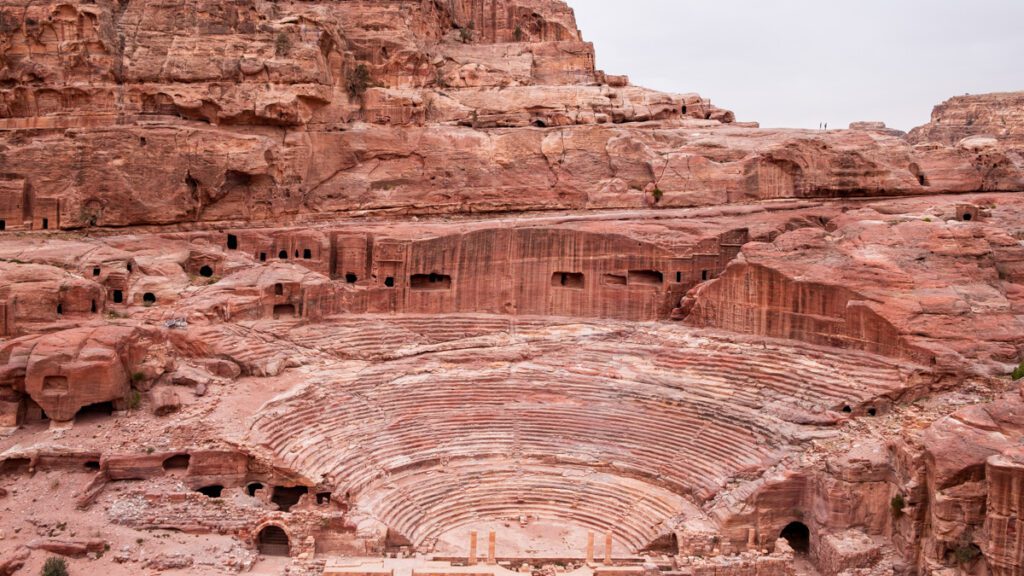
The Petra Amphitheater was built in the 1st century CE, during Roman times. It could seat anywhere from 4,000 spectators to 8,000 spectators. Sources vary on the actual number.
It’s believed that the theater was used for hosting various performances and events like theatrical and musical performances, religious ceremonies, and public speeches. These events played an important role in the cultural and social life of Petra during Roman times and helped showcase the city’s wealth and prestige.
7. The Djinn Blocks, mysterious structures to see in Petra
One of the first structures you’ll see after entering the site is the Djinn Blocks. They are located on the path between the main gate of Petra and the Siq.
There is a lot of mystery around the Djinn Blocks, the three massive squared monuments.
The term “Djinn” refers to supernatural beings in Arabian folklore. The name “Djinn Blocks” reflects the enigmatic nature of these structures, which have sparked different interpretations and legends over time.
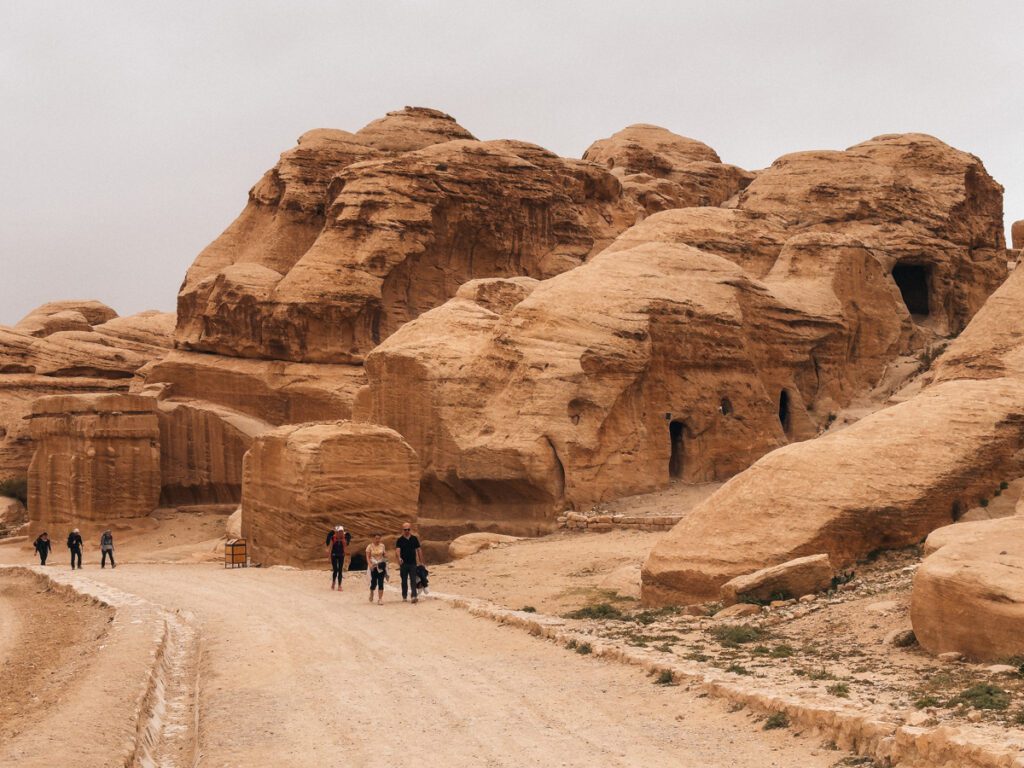
That’s why the actual purpose of the Djinn Blocks is still unclear. There are 3 possible uses. The first is the typical Nabatean tomb, probably for a person of higher stature because of the designs.
Some scholars believe that the Djinn Blocks had a religious or ceremonial function, possibly related to ancestor worship. The final popular theory is that the Djinn Blocks served as landmarks to highlight the boundaries of important areas within Petra.
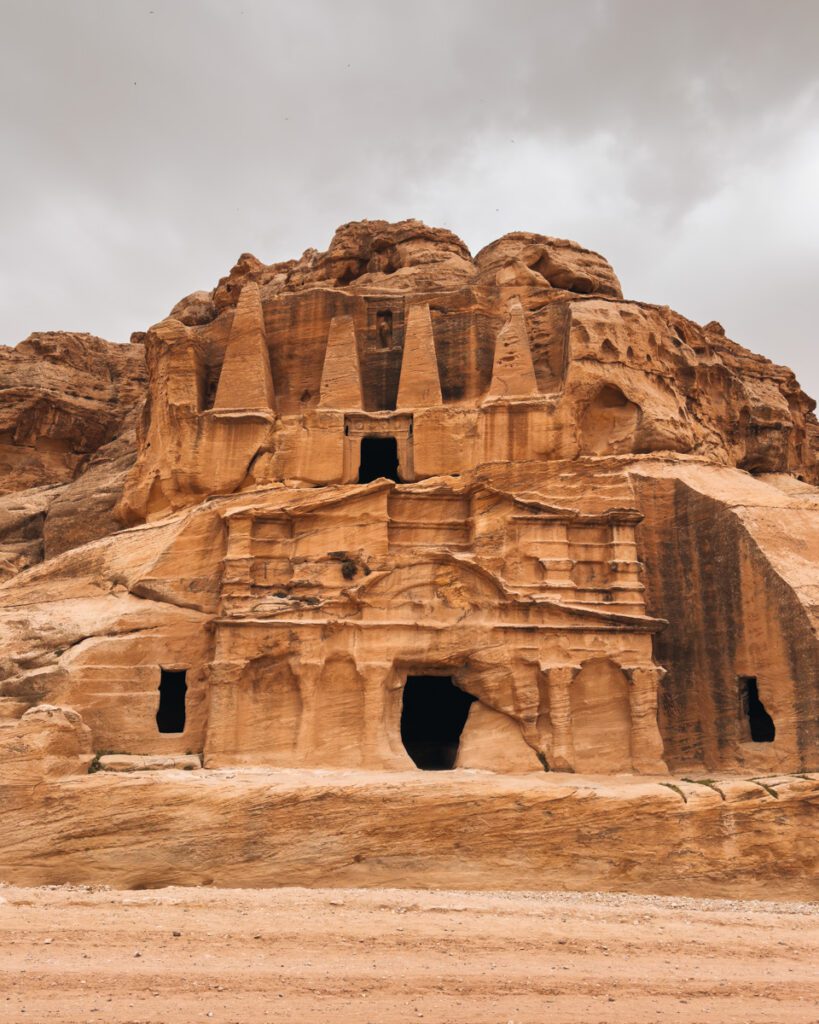
Next to it, you have the Obelisk Tomb. It was carved by the Nabateans in the 1st century CE. Above it, you have 4 pyramids and a niche with a statue in bas-relief that symbolizes the 5 people buried there. Below it, you have the Triclinium, a banqueting hall.
The obelisks, about 7 meters high, are influenced by the Egyptian architectural style. But you can also notice that they have Hellenistic style. This was typical of the Nabatean art – they would often blend different styles together.
The Bab as-Siq Triclinium is also known as the “Banquet Hall”. It was used for ceremonial feasts held in honor of the deceased. It’s located next to the Obelisk Tomb, carved into the rock face.
It’s a first initiation to what you’ll see inside Petra, and all this before getting to the Siq.
8. The Colonnaded Street, one of the must-sees in Petra
You can’t miss the Colonnaded Street. Located past the Royal Tombs, this is one of the best things to see in Petra. It stretches from the entrance of the Great Temple to the Qasr al-Bint Temple.
The Colonnaded Street is one of the most impressive remnants of Petra’s urban landscape. As its name indicates, it’s a street lined with columns. It represents an original Nabatean creation, although it was later refurbished during the Roman occupation.
The Romans added the features like the colonnades and paved roads. They transformed the street into a grand avenue facilitating trade and local activities. After all, Petra was a commercial hub in the area during its glory days.
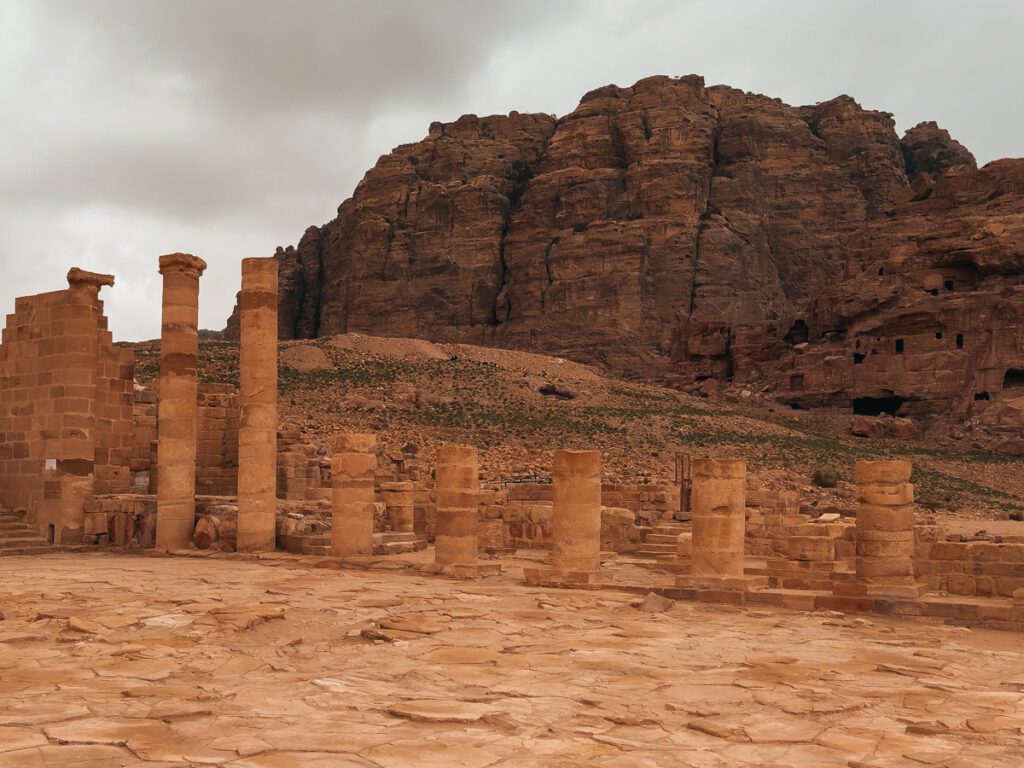
The Colonnaded Street was one of the main shopping streets in Petra. Imagine what it might have been like when the city was inhabited. A bustling market with vendors.
During excavations along the Colonnaded Street, they found a ton of artifacts that provided insights into the daily lives of Petra’s inhabitants. Some of the things they found were pottery, coins, and architectural fragments.
You can see some of these findings at the Petra Museum, right before the Visitor Center.
9. The Great Temple, one of the best things to see in Petra
Spanning an area of approximately 7,000 square meters, the Great Temple is another one of Petra’s highlights. It’s also one of the most important structures here.
Since it’s in the middle of the site, we can understand that it played a significant role during the Nabatean and Roman times.. It’s located right next to the Colonnaded Street, a main hub of Petra.
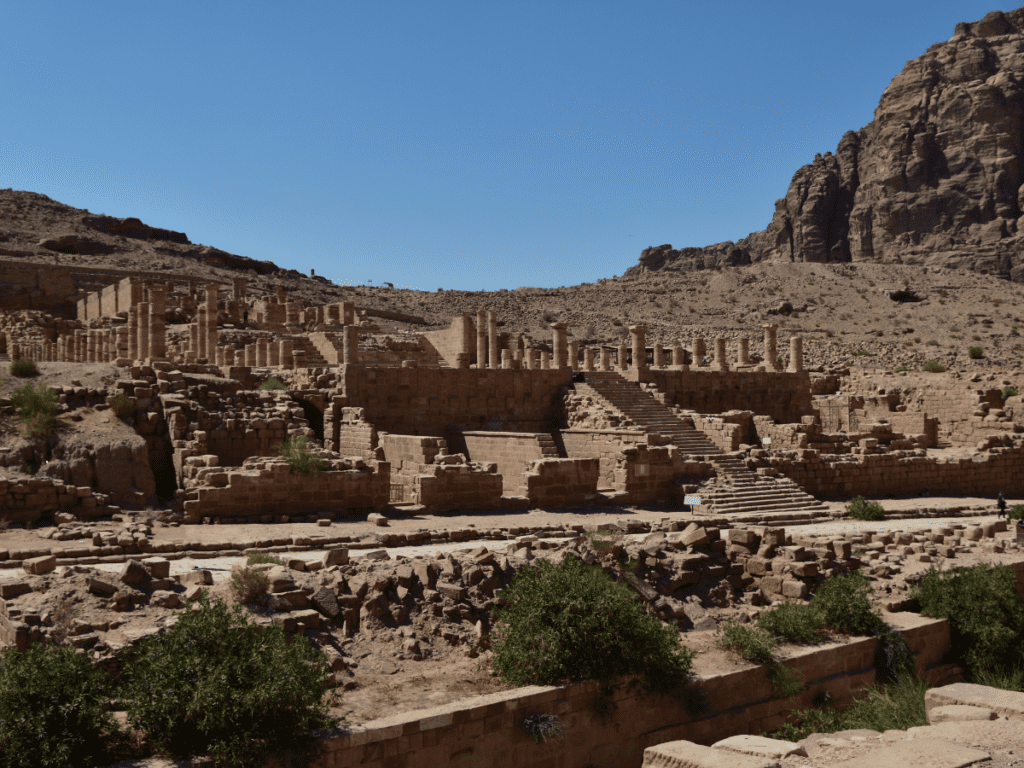
The Great Temple of Petra features a mix of Nabatean and Greco-Roman architectural styles. It was built in the first century BCE and expanded over several centuries.
During excavations, many different artifacts were found here that gave scientists a glimpse into the building’s purpose.
As its name suggests, it’s believed to have served as a major religious and civic center back in the day. Although its exact dedication remains uncertain, scholars believe it was likely associated with Nabatean deities, like Dushara and al-Uzza, as well as Greco-Roman ones like Zeus and Dionysus.
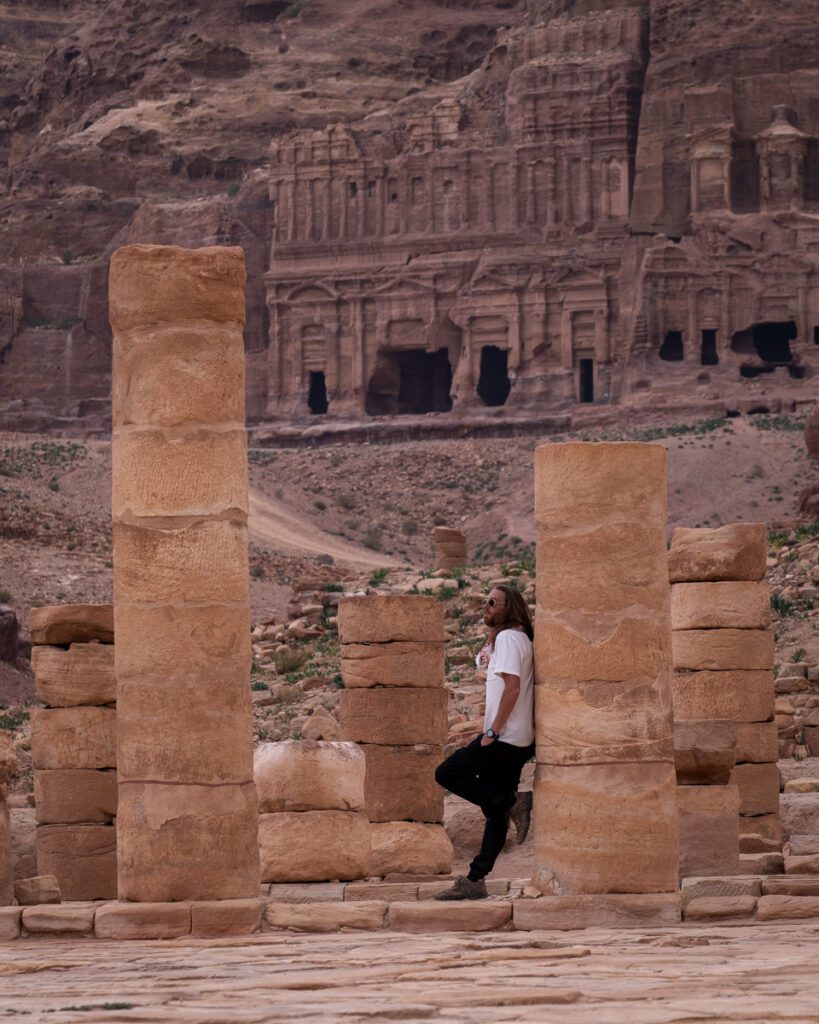
You’ll be able to access the Great Temple from the stairs that lead to it. There, you’ll see the colonnaded courtyard and more stairs. As we mentioned, the site is quite large, so it stretches out quite far.
Walking around, you’ll be able to see a central platform which was likely used as a ceremonial space. Next to it, there are a series of small rooms and chambers. They may have been used for religious or administrative purposes.
One of the most remarkable features of the Great Temple is its large, open-air auditorium. It could accommodate up to 600 people. It shows that the Great Temple was probably used for public gatherings, meetings, and possibly theatrical performances as well.
On your first day in Petra, we recommend quickly scanning the Great Temple, unless you have time to fully explore it. If not, on your second or third day here, you can spend more time scouring the 7,000 square meter area.
Beyond its sheer size, the significance of the Great Temple makes exploring it one of the best things to do in Petra.
10. Qasr al-Bint, an important structure in Petra
Another impressive structure is the Qasr Al-Bint, also known as the Temple of Dushares. In Arabic, it translates to “Castle of the Daughter”.
The Qasr, which dates back to the first half of the 1st century CE, is one of the oldest structures in Petra. It’s a square structure that is set on a podium. It’s located between the Great Temple and the restaurants that lead up to the Monastery.
When we visited, it was impossible to explore it fully as parts were under maintenance.
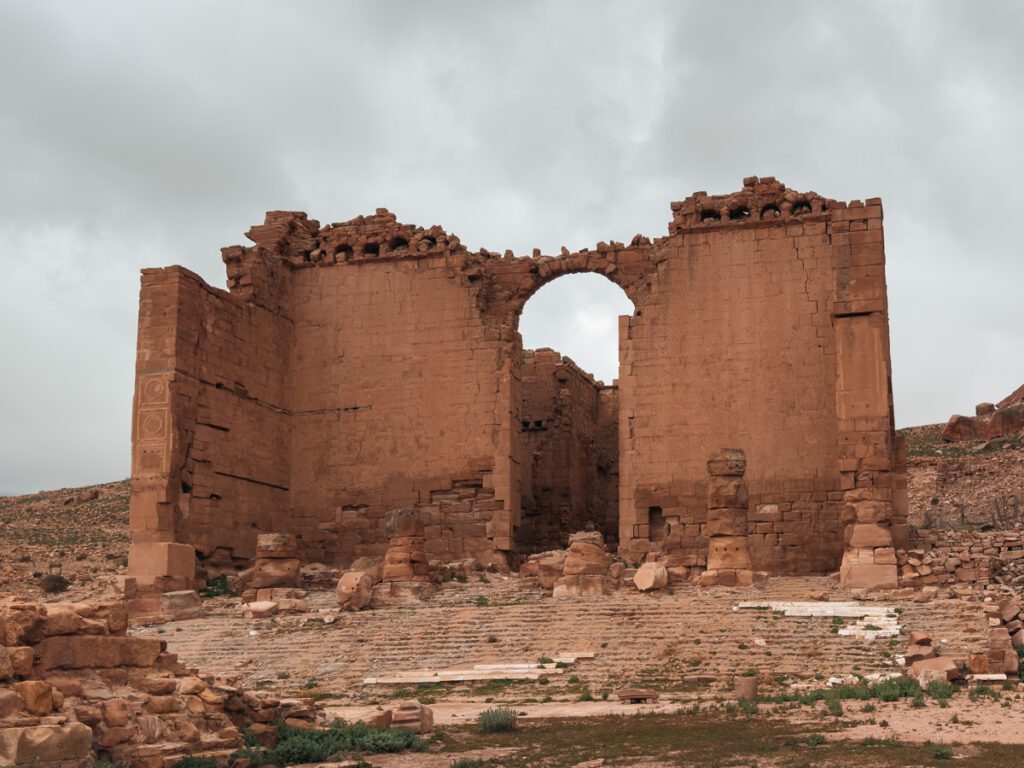
Back in the day, this Qasr was the main and most important temple in Petra. It was dedicated to Dushara, the main deity worshiped by the Nabateans. Dushara was considered the chief god of the Nabatean pantheon and was often associated with fertility, agriculture, and the protection of the city and its inhabitants.
Excavations at Qasr al-Bint have uncovered different artifacts, including inscriptions, pottery, and religious objects. Since the Nabateans believed that Dushara played a crucial role in ensuring the prosperity and well-being of their community, they offered prayers and sacrifices to appease him. The discovery of altars, offering tables, and remnants of incense suggests that Qasr al-Bint was often used for these purposes.
If Qasr al-Bint is open when you visit, we recommend taking the time to explore it on your first day.
Hidden gems in Petra
Beyond the top 10 must-sees in Petra, there are many different hidden gems here that are also worth exploring. Here are a few of them we recommend taking the time to explore.
Our main recommendation would be to explore these places to see in Petra on your second or third day here. Although some are impressive, the highlights we listed before are culturally more significant.
11. Hike from Little Petra, one of the best things to do in Petra
Many visitors to Petra fully ignore the fact that there is this hidden gem all the way out of the main site of the Ancient City of Petra. But it’s totally worth visiting, especially since it’s free to visit Little Petra.
Little Petra is known as Siq al-Barid. Although it’s not as big or grandiose as Petra, Little Petra is well worth visiting in its own right. Especially since it’s quite easy to get to!
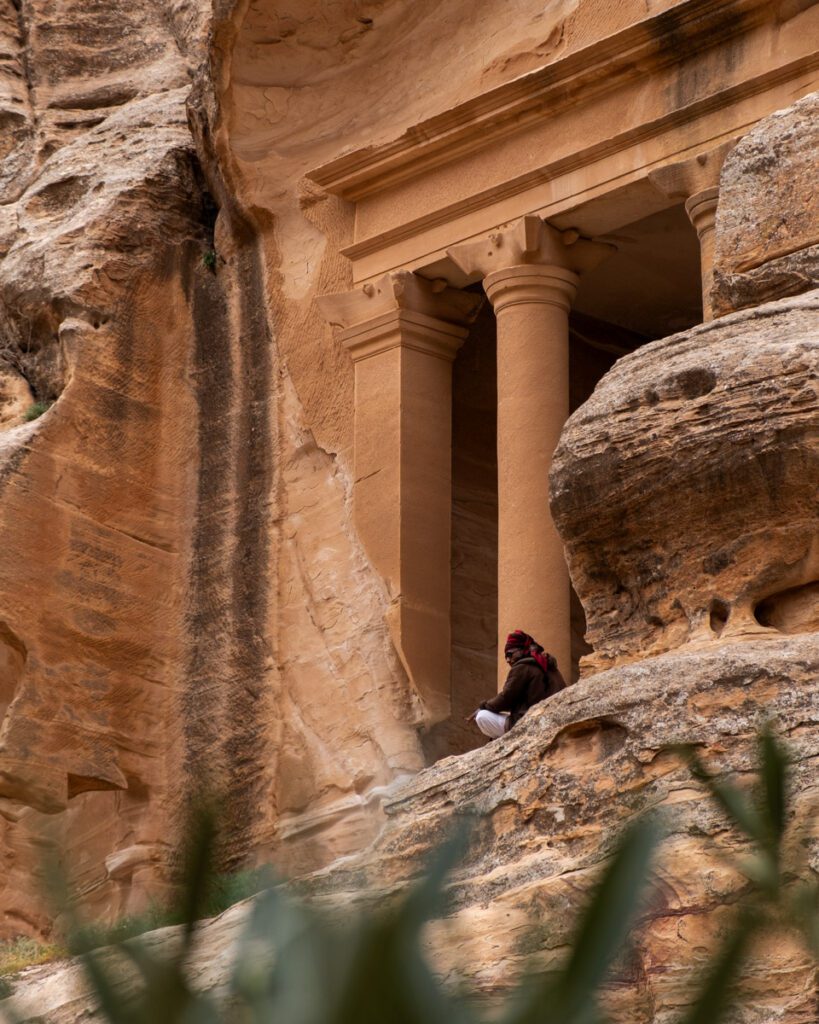
The best way to get to Little Petra is to take the free shuttle that runs every 30 min from 7:30 am to 2 pm. You can catch it behind the Petra Museum. It’s a charming site and it has historical significance when it comes to Petra.
Just note that the shuttle doesn’t always run on time. They often wait until there are enough people on the bus to get going. We got to the bus on time at 10 am and waited 15 min before leaving.
During your ride to little Petra, sit on the driver’s side to get the best views. The ride is only 15 minutes long and it’s a beautiful journey. The shuttle will take you to the entrance of Little Petra.
The highlights of Little Petra
Little Petra was an important suburb closely connected to the main city of Petra. It’s believed to have functioned as a trading and agricultural center, where caravans and traders could rest and resupply.
Your visit to Petra shouldn’t take more than an hour, unless you choose to hike down the route past the Siq.
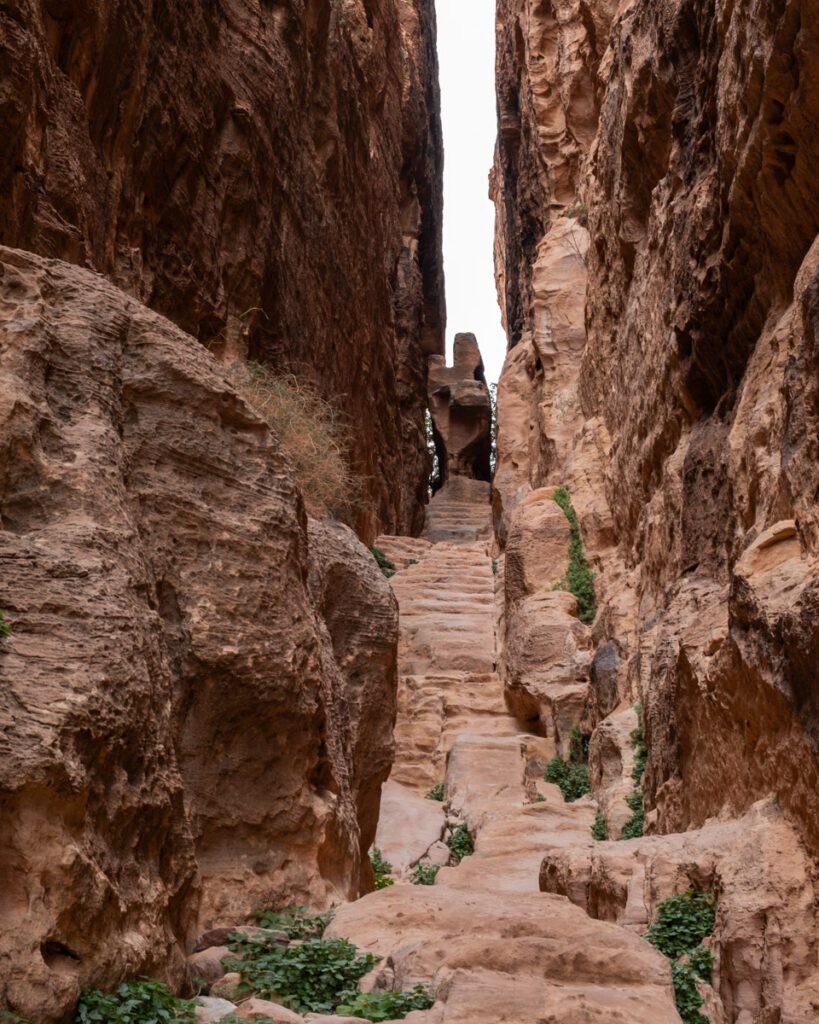
Here are some of the highlights you can visit here:
- Like Petra, Little Petra has some impressive architecture carved into the cliffs. There are facades, chambers, and cisterns. And even if it’s on a smaller scale than Petra, the buildings at Little Petra showcase similar Nabatean craftsmanship and design elements.
- Just like Petra is accessed through the Siq, Little Petra has a similar narrow canyon, known as the Siq al-Barid, or “Cold Canyon.” It’s not as dramatic as Petra’s Siq. But this canyon still offers a scenic approach to the site, with towering cliffs and intriguing rock formations.
- One of the unique features of Little Petra is the painted frescoes on some of the chambers’ interior walls. You can see some of them in the carved sections. However, with time, they are not very impressive to see today.
Although off the beaten track, Little Petra is a great site to visit if you have the time. We recommend keeping its visit for your second day of exploration, We also recommend hiking from Little Petra to the Monastery, if you have the time and energy to do it.
12. The High Place of Sacrifice, one of the hidden gems in Petra
The High Place is hard to get to, and it’s spread out quite far. This is why it’s still one of Petra’s best kept secrets.
We only recommend visiting the High Place of Sacrifice if you have the time and energy to do it. It’s best to do this on your second or third day in Petra. After hiking from Little Petra, we didn’t have a chance to see the High Place of Sacrifice.
Known in Arabic as Al-Madhbah, The High Place of Sacrifice is one of the most significant and atmospheric sites in Petra, Jordan.
The High Place of Sacrifice is located at the top of a hill, overlooking Petra. It’s a hard hike up to this Petra attraction – about 3 km long, and taking between 3.5 to 4 hours.
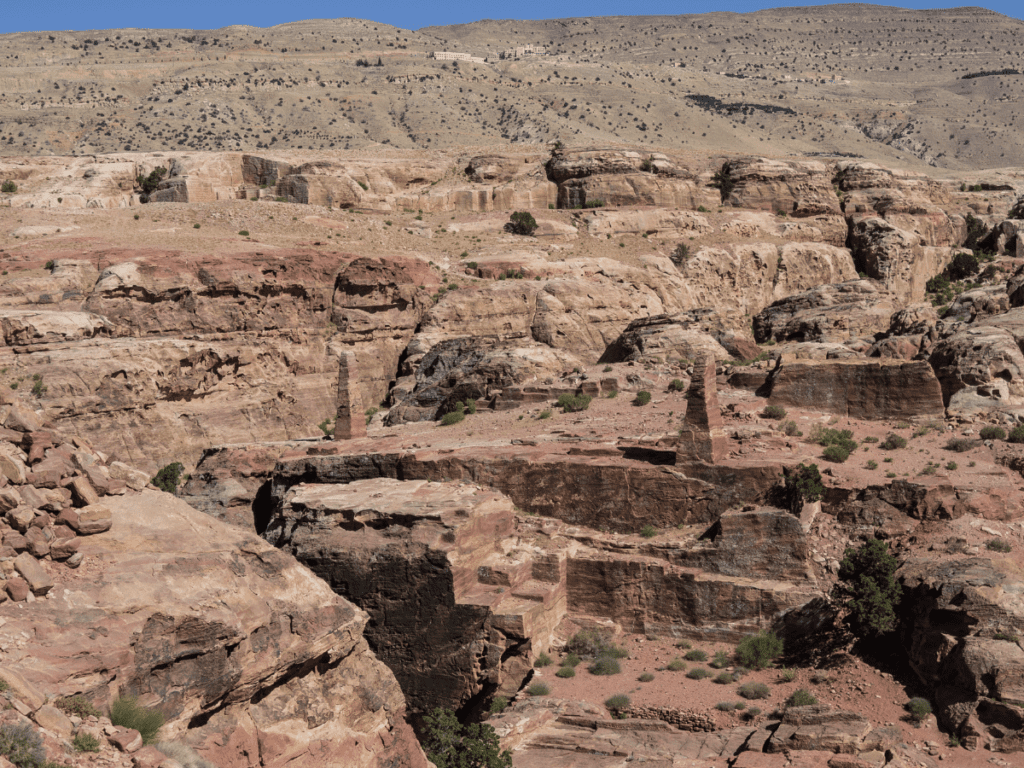
As its name suggests, the High Place of Sacrifice was dedicated to ritual ceremonies and offerings. The Nabateans built this high-altitude sanctuary to perform offerings of animals to their gods.
You can find the stairs leading up to it before getting to the amphitheater. You’ll need to climb up rock-cut stairs for about 30 minutes before reaching the main site.
The main highlights of the site are the altars, obelisks, triclinium and panoramic views of the surrounding landscape.
After the altar, you will see two tall obelisks, Zibb Atuf and Zibb Attuf. They are thought to represent deities or to serve as markers for the sacred site. Next to the main altar is a rock-cut triclinium, a dining room where ritual feasts and gatherings would take place after the sacrifices.
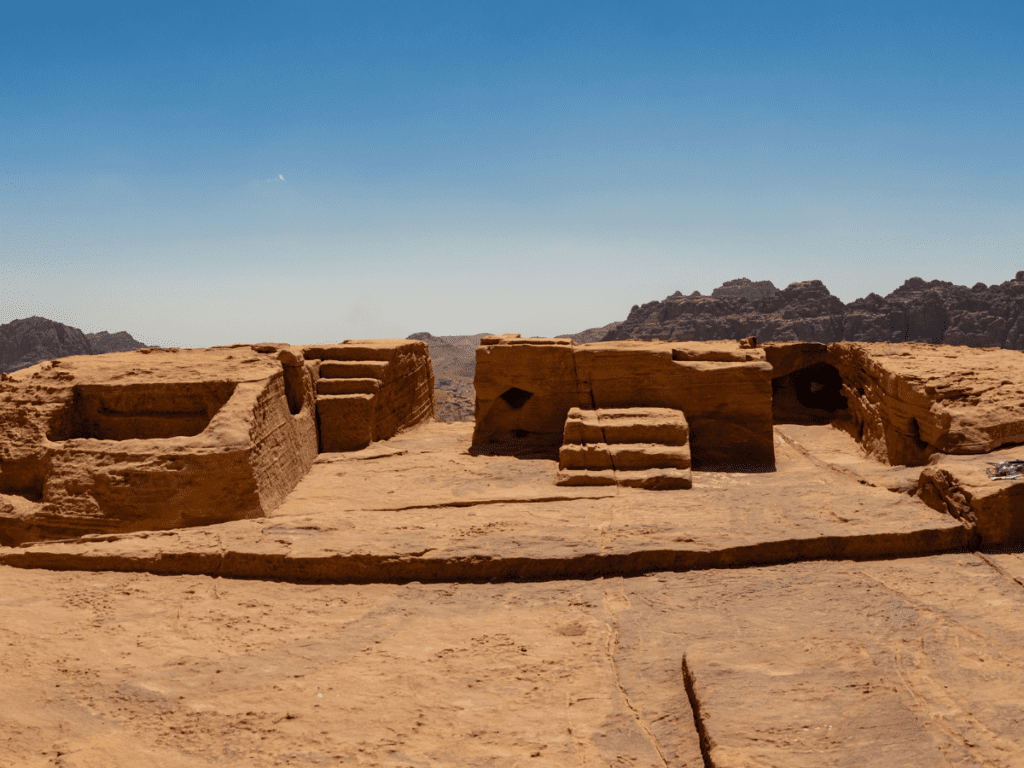
Hiking deeper into the High Place of Sacrifice
After climbing to the High Place of Sacrifice, you can go even deeper into the area by descending the valley of Wadi Farasa.
After the main highlights, there is a path that leads down to the Lion Fountain. After this, you can see a first complex known as the Garden Tomb, which archaeologists believe was more likely to have been a temple. Find out more about it below.
Below it is the Tomb of the Roman Soldier, one of the finest tombs in Petra, and another hidden gem. From there, you’ll get to the Renaissance Tomb which leads to the Pharaon Column.
If you want to know more about this hidden gem in Petra, we recommend getting a guide (100 JOD) or a guide to hike with you through this special place. It’s well worth it if you have the energy and time to make it up here.
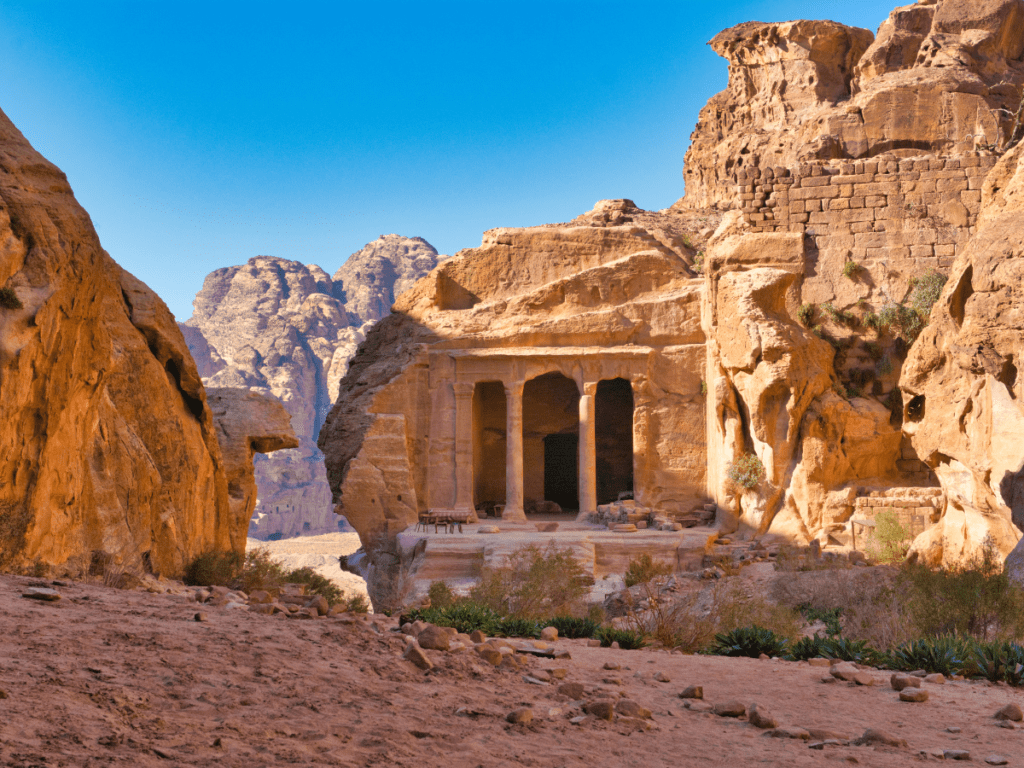
13. The Garden Temple, one of Petra’s best kept secrets
The Garden Temple is one of the most unknown structures in the Ancient City of Petra. It’s located within the complex known as the “Sacred Garden” and is accessible when you hike up to the High Place of Sacrifice.
The Garden Temple dates back to the 1st century BCE and is thought to have been part of a larger complex. This temple is surrounded by gardens and pools.
The temple’s precise function is still unclear, but it likely served both religious and social purposes. The Garden Temple is characterized by its small size and elegant design. The structure includes a central courtyard, a series of rooms, and an inner sanctuary.
Here, you can see one of the most sophisticated water management systems in Petra, including channels, cisterns, and basins. This is how Nabateans were to create lush, verdant spaces in this harsh desert environment.
The Garden Temple is a quieter spot within Petra. If you’re looking to escape the crowds, it’s a great spot to explore.
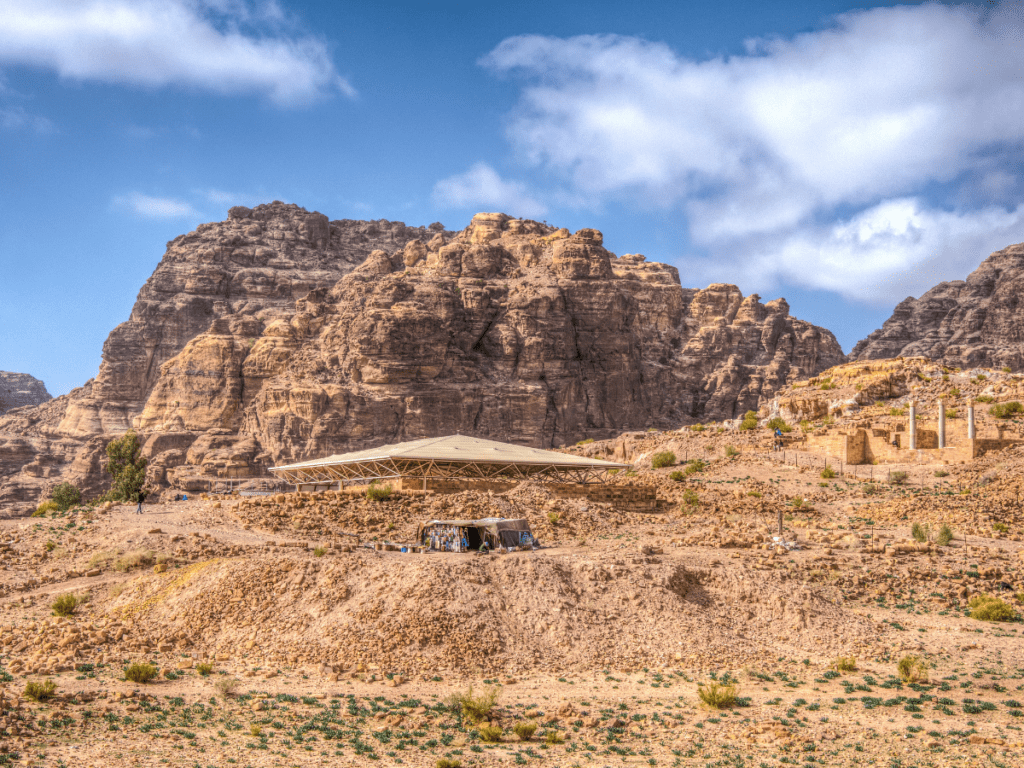
14. The Byzantine church, a lesser-known place in Petra
The Byzantine Church is located parallel to the Colonnaded Street, just up a little hill. There are signs pointing to it from different locations.
The church dates back to the 5th and 6th centuries CE. This is when Petra went from being a Nabatean city to a Byzantine, Christian community. During this time, the cultural and religious landscape of Petra changed vastly. You can still see traces of this throughout the site.
The church features a basilica layout and its most remarkable feature is the floor mosaics. They’re really well-preserved and depict different scenes, with geometric patterns, floral designs and representations of animals and humans.
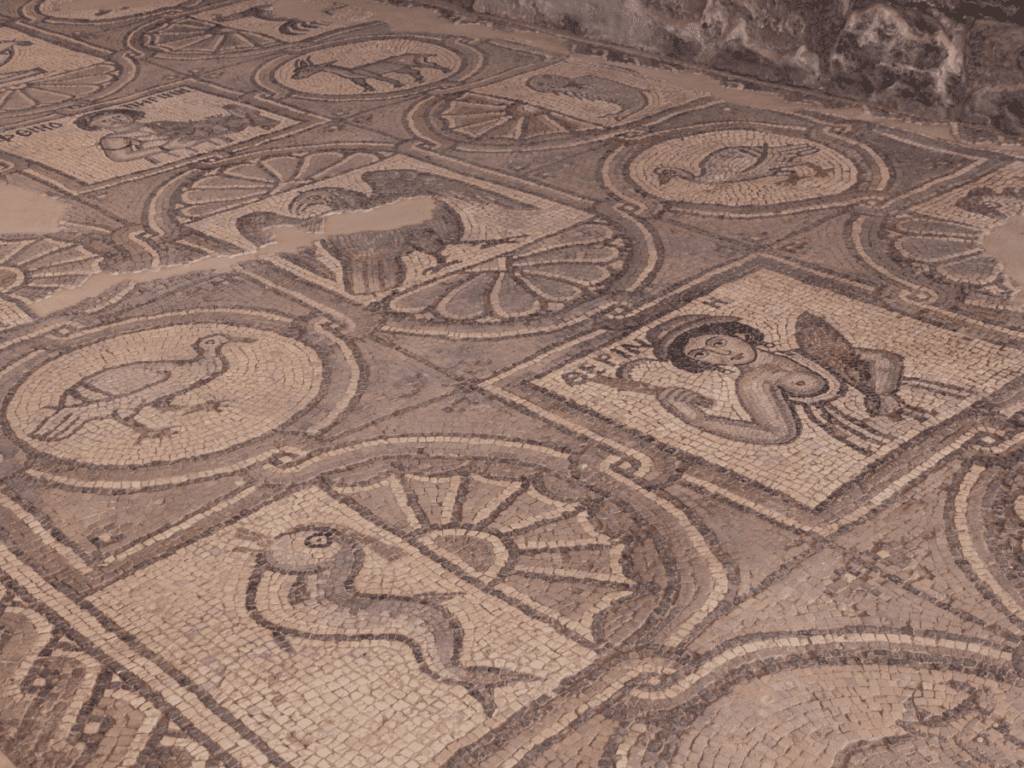
At the church, you’ll also notice a baptistery with a basin which gives us a glimpse into the practices they did here. There are also adorned columns that have survived the test of time.
During excavations of the church, many different artifacts were found here, including the typical pottery, coins and inscriptions. There were also many Christian religeous objects that were discovered.
We recommend visiting the Byzantine church either on your first day or on your third day. We kept it for the day we hiked from Little Petra, and didn’t get around to it. We were just too tired of walking 25,000 to 30,000 steps a day for 2 days straight!
15. Aaron’s Tomb, Petra’s best kept secret
We had no idea about Aaron’s Tomb until we started researching to write this article. It’s truly a hidden gem in the Ancient City of Petra. It’s said to be the burial place of Aaron, brother of Moses.
When we say this is one of Petra’s hidden gems, we mean it. It was only rediscovered by the Swiss explorer Burkhardt in 1812. The same explorer who rediscovered Petra.
Aaron’s Tomb is one of the most significant religious and historical landmarks in Jordan. To reach it, you’ll need to hike toward Jebel Haroun from Qasr Al-Bint. It’s a difficult 7-mile hike from this starting point. This trek will take about 3.5 hours.
Standing at 1,350 meters tall (4,580 feet), the mountaintop where the tomb is located can only be reached by foot. Note that the trail is not marked. Considering we got a little lost hiking from Little Petra to the Monastery, we recommend that you take a guide to visit this site. He will also be needed to enter the shrine.
Once you get here, you’ll be rewarded with the discovery of the tomb, as well as impressive views of the area.
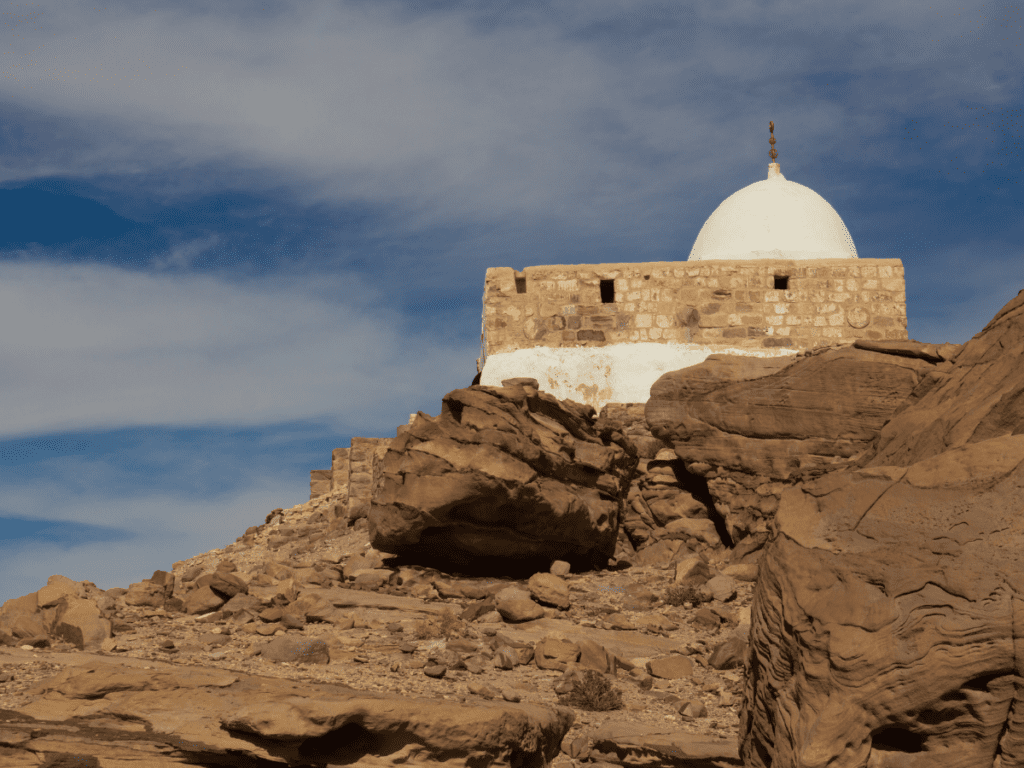
The tomb is housed in a white-domed structure, a common feature in Islamic shrines. The building is relatively simple. Next to it, you’ll find a small mosque which is still used today by visitors.
If you plan on hiking to Aaron’s Tomb, we highly recommend going with a guide. Considering cell service isn’t always reliable in this part of the country, you don’t want to get lost.
Also, make sure you go prepared with enough water, food and proper shoes. Cover up and wear sunscreen as there is little to no shade in the area.
Go on a hike, one of the best things to do in Petra
Beyond discovering the beautiful structures in Petra, there are quite a few hiking trails you can explore as well. In this section, we’ll give you a few details about the trails available to you from Petra.
We recommend being prepared if you want to go on a hike in Petra. This means wearing appropriate shoes and clothes (sun protection is key), having enough food and water, and, in some cases, having a guide with you.
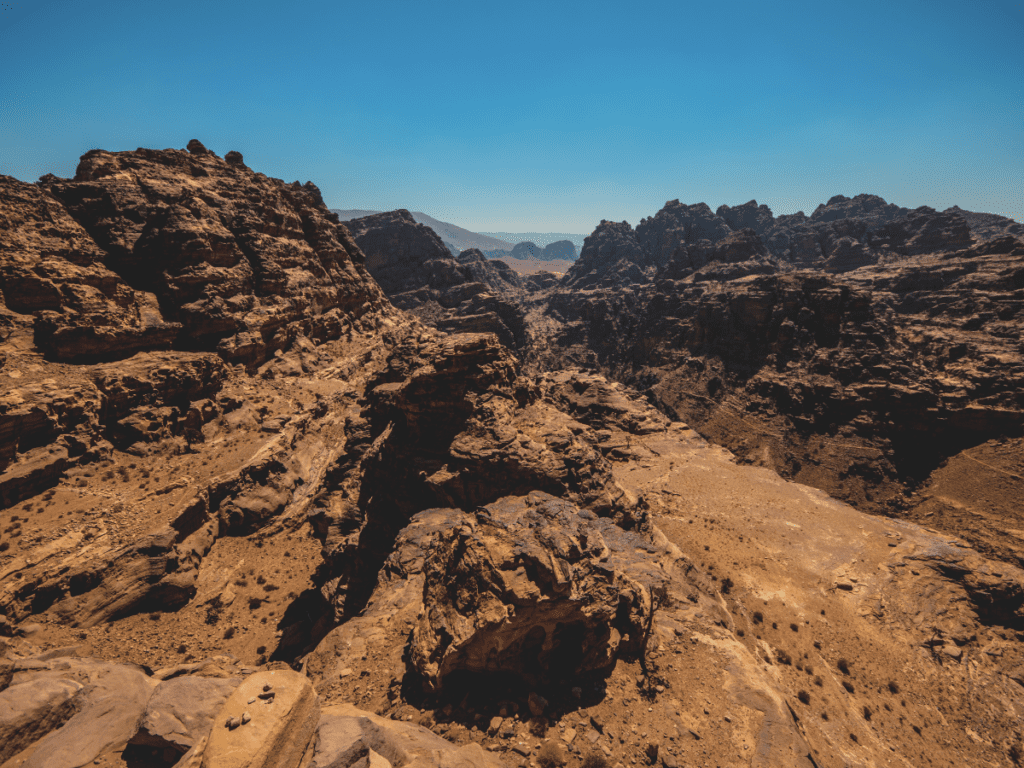
16. Discover the Al-Khubtha trail to get a great view of the Treasury
If you’re looking to see the Treasury through a very different vantage point, this is a great hike to do in Petra. The Al-Khubtha trail will take you in front of the Treasury, but from an altitude.
The trail starts on the left of the Palace Tomb and trails behind the Royal Tombs. The hike up to the main plateau will take about 40 minutes. It’s a steep and strenuous hike, but it’s not a difficult one. You’ll be climbing up some stairs that are well-maintained for the first part.
From the first ascent, you’ll have a great view of the Amphitheater, and in the distance, you can clearly see the Colonnaded Street, the Great Temple and Qasr al-Bint. This hike is a great way to get a bird’s eye view of the main center of Petra.
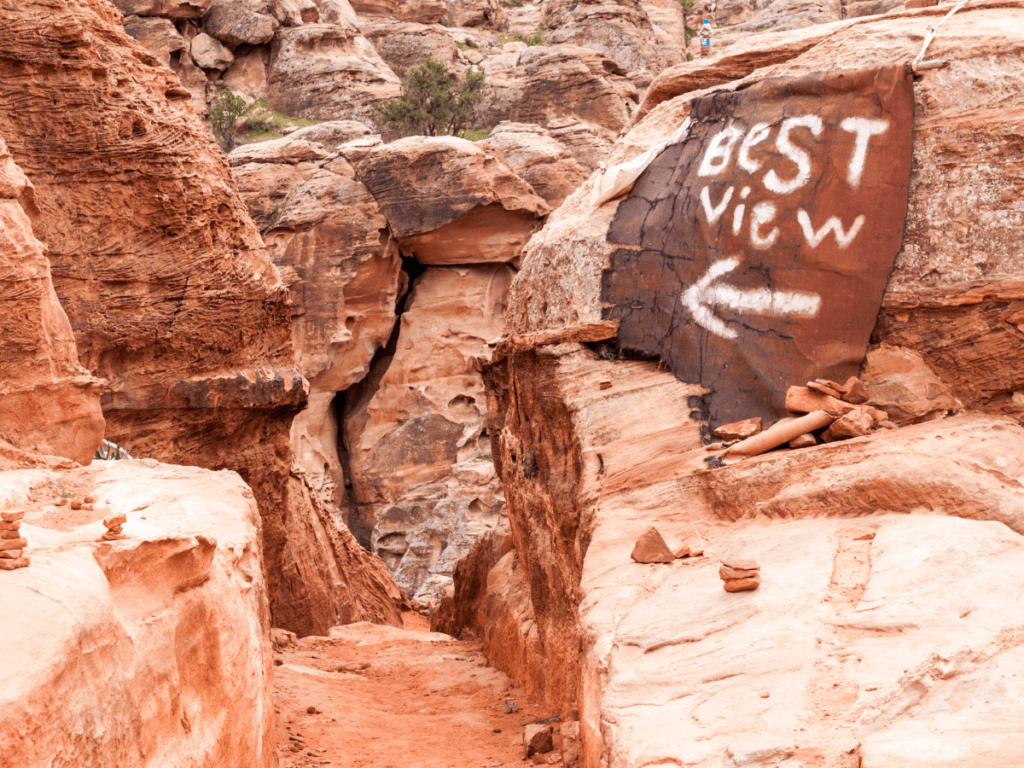
As you continue along the trail, you’ll see a colorful tent that says “Best View”. They’re not kidding. From there, you’ll be able to see people trickling in through the Siq.
If you want to see the Treasury lit up with the sun’s light, you’ll need to do this hike quite early in the morning. It’s the only time the Treasury has light on it.
The morning is also a great time to do this hike as it can get quite hot later in the day. Considering it’s a 3.5 km (2.2 mile) hike round-trip, which should take between 2.5 to 3 hours, it’s not a bad idea!
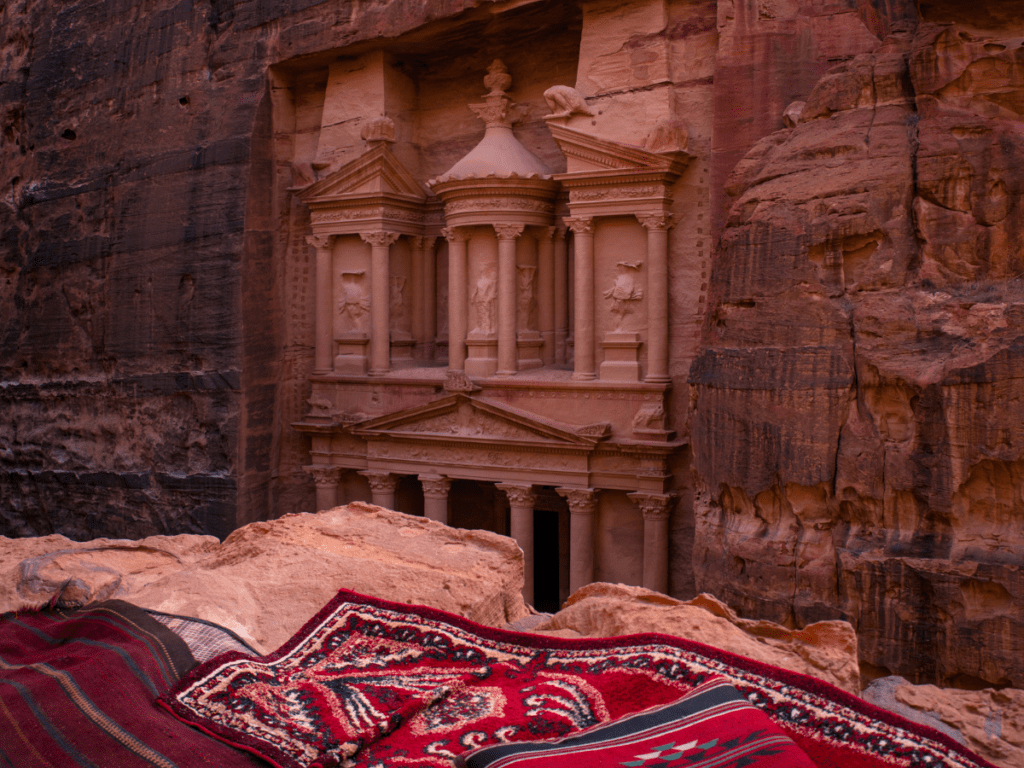
17. High Place of Sacrifice Trail, a more popular hiking trail
Of all the hiking trails in Petra, this one is probably one of the more popular ones, although it’s still not that busy. The High Place of Sacrifice requires quite some effort to get to. When people only spend 1 day in Petra, it’s easy to skip it.
This 3 km (1.9 miles) hike is considered to be a hard one as there is a steep ascent. And it does trail up and down the valley, which means you should be wearing sturdy shoes.
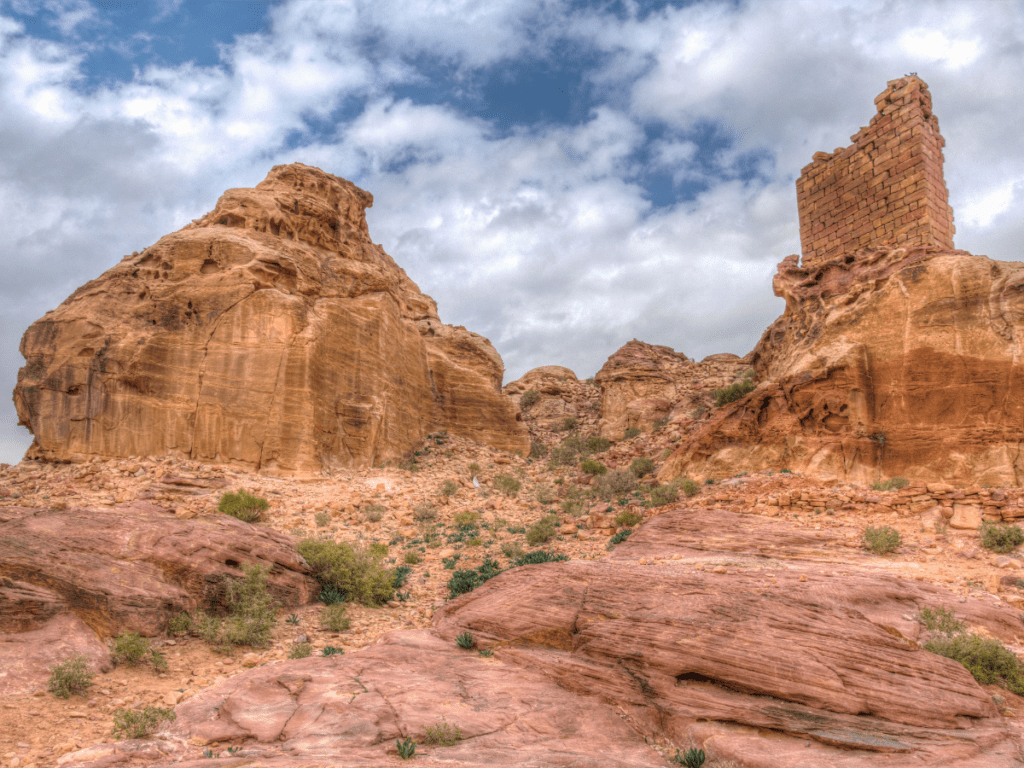
As we mentioned, this trail will take you through the main part of the sacrificial site – the altar, the obelisks and the triclinium. You’ll also see the Garden Palace, the Roman Soldier’s Tomb and the other sites in the area.
After this, you’ll be able to hike the Wadi Al Fasara through the South City Wall. Along the way, you’ll cross other hiking trails: the Jabal Haroun Trail and the Sabra Trail.
The trail for the High Place of Sacrifice finishes behind Qasr Al-Bint.
18. Umm Al-Biyara trail, a lesser-known hiking trail in Petra
If you’re looking to get a little more off the beaten track in Petra, this hike is for you. It is a good half-day hike, about 4 hours there and back. Make sure you have ample time in your Jordan Itinerary to do it.
This is a 4-km (2.5-mile) round-trip hike known as the Mother of Cisterns. This is Petra’s highest and most prominent mountain, which means you get amazing views of the Ancient City. You can even see the Monastery and Little Petra.
The hike starts behind Qasr Al-Bint. It starts at the same spot as the Jabal Haroun and Sabra trails. The beginning of the hike is probably the most challenging – it’s a steep ascent.
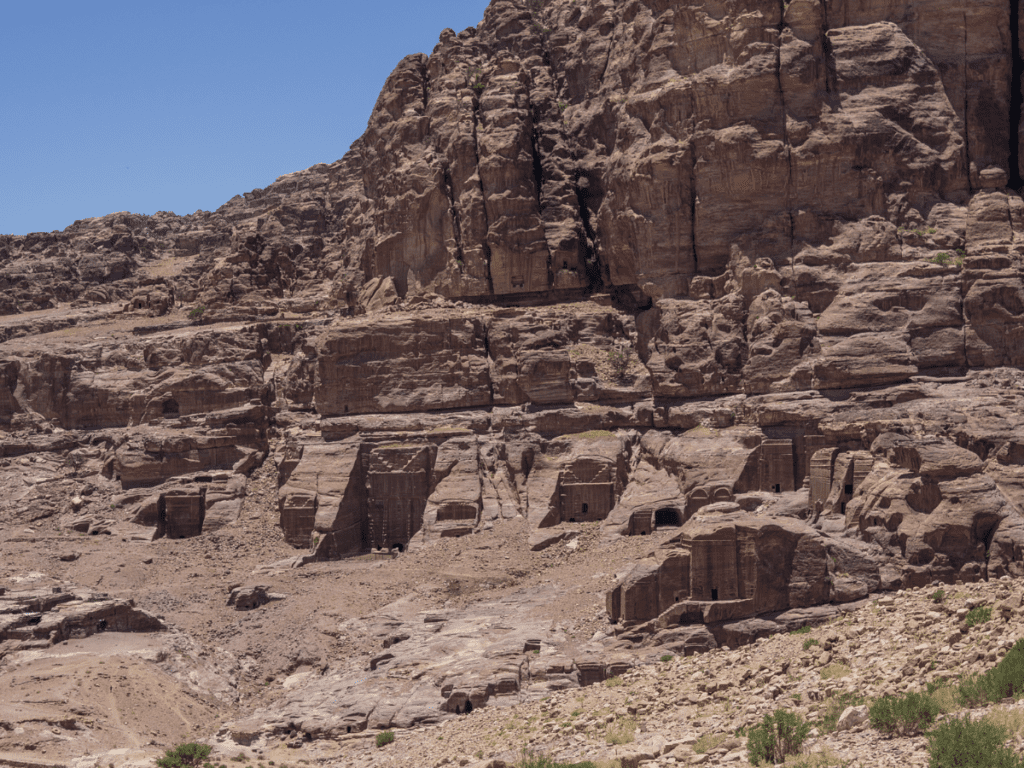
Alternatively, you can also hike this trail while you’re on the High Place of Sacrifice trail. You’d have to walk a part of the Sabra and Jabal Haroun trail to get to it.
At the top of the mountain, you’ll find the remains of the Edomite buildings that date back from the seventh century BCE, as well as a Roman bathhouse. Along the trail, you’ll also see other Nabatean tombs and the Snake Monument, which looks like an ice cream cone.
If you plan on hiking this trail, we recommend you get an early start. The sun’s heat and lack of shade (plus the strenuous climb) make this hike a harder one to do. Also, make sure you have sturdy and comfortable shoes, and that you wear light breathable clothes that will shelter you from the sun. Bring lots of water and snacks.
19. Madras Trail, a hidden gem of a trail in Petra
The Madras trail is another one of Petra’s hidden gems. It’s actually known as the Indiana Jones Way. It’s a short 1.5km hike that should take about 1.5-2 hours roundtrip. It can be done alone or with a guide.
This trail actually starts before entering the Siq, right at the Dam. There’s also an option to start it around the Djinn Blocks, past the Snake and Obelisk Tombs.
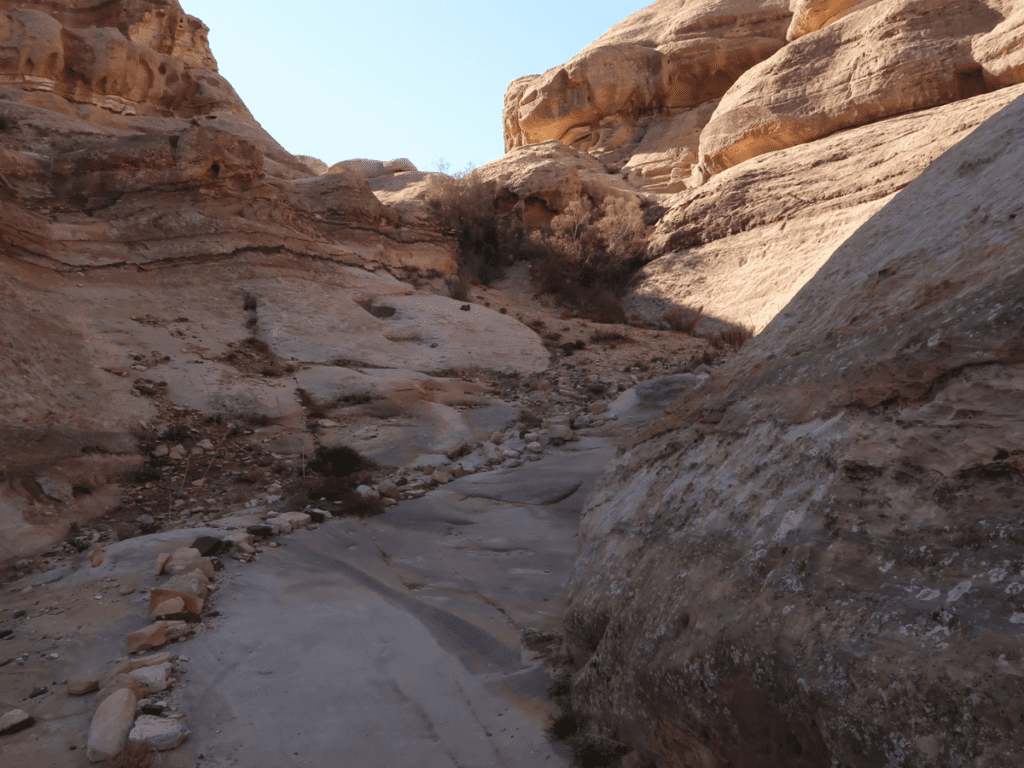
If done fully, the Madras trail joins the High Place of Sacrifice. Alternatively, you can turn back after seeing the highlights, one of which is seeing the Treasury, from another elevated viewpoint.
Instead of walking through the Siq, the Al-Madras route takes you around and above it. Along the route, you’ll see an oil press, cistern, and several sacred relics, like another “high place” and a meeting hall for Nabataean religious purposes.
Although this trek is a short one, it’s not that easy. There is quite a bit of elevation gain, and you’ll need to go up and down quite a few slopes. As with the other treks, make sure you’re adequately prepared with proper gear, water and snacks.
20. Jabal Haroun Trail, the hike to the highest peak in Petra
This is the trail to hike to see Aaron’s tomb. It can be done starting from Petra, behind the Qasr Al-Bint.
Jabal Haroun is the highest peak close to Petra. Although it was discovered by Burckhardt in 1812, he didn’t actually climb to the peak then. The first ones to scale the mountain were Englishmen Irby and Mangles, in 1818.
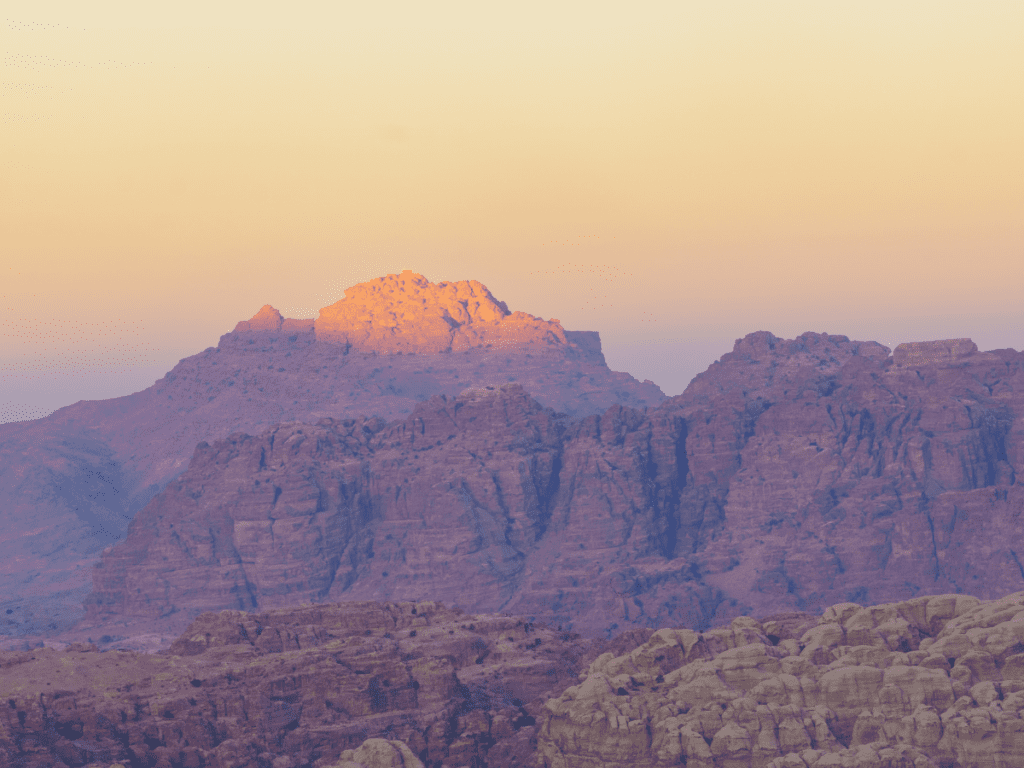
Today, with the help of a guide, you can also get to the peak of Jabal Haroun. The route is about 7.5 to 11 km and can be done in 4 to 6 hours depending on where you start, your pace and stamina.
Although it’s not a super hard hike, there is some elevation gain and some of the ascents are steep. Make sure you’re prepared with adequate water, snacks, shoes and gear.
21. Sabra Trail, hike this route for amazing views of Petra
This is another hike that starts behind Qasr al Bint. It follows the same trail as the Jabal Haroun route but deviates at one point. It’s highly recommended to go on this trail with a local guide.
This walk will take you to the less-known parts of Petra, all the way to Sabra, a wadi which is located south of the main city. Sabra is known as a significant Nabataean-Roman site. It served as a major caravan station and settlement between the 1st and 4th centuries CE.
As with the other trail, you’ll have a steep ascent in the beginning. Before reaching the valley, you’ll come across some secluded archeological sites like a theater, acropolis and Roman baths.
These sites are still being excavated, so be mindful as you hike this trail.
Although there is a good elevation gain, the hike is not difficult. The rougher patch will be a walk in the sandy bottom of the wadi at the last third of the way.
The Sabra trail is about 10 km long and should take about 6-7 hours to do roundtrip. Make sure you’re prepared with water, food and gear.
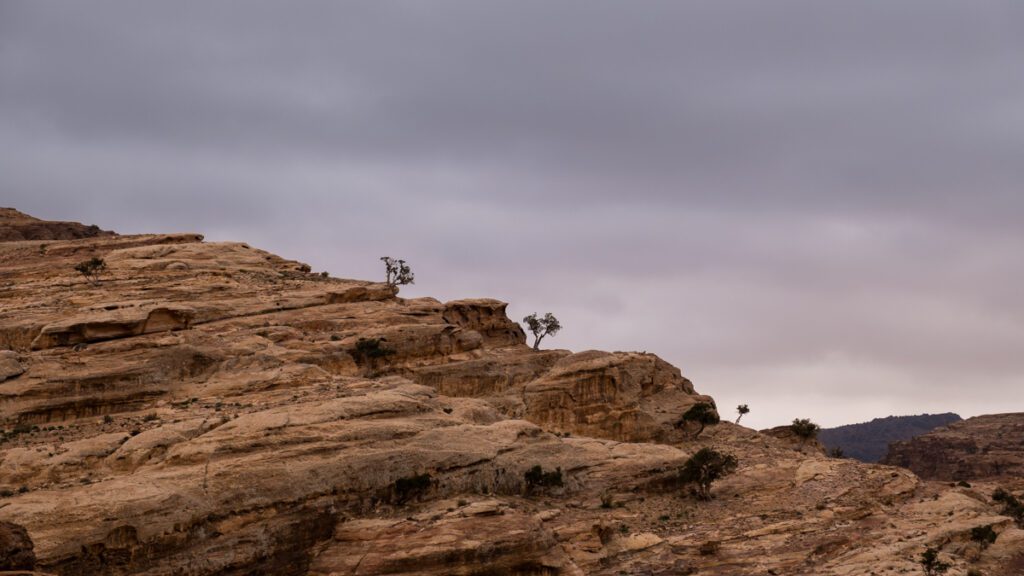
22. Petra the Backway, the best way to explore Petra
In our opinion, this is the best way to hike to the Monastery, and it’s for free. The hike is a good 5-6 hours from Little Petra back to the main Petra gate, but it’s well worth it.
There are 2 ways you can get to Little Petra. You can either take the free Jeep there from the back of the Petra Museum, or you can take a cab which will set you back 15 JOD.
After exploring Little Petra, you can take the trail that starts to the left of the ticket office. From here, you’ll walk through a Bedouin settlement until you get to the back stairs of Petra. Alternatively, you can take the Jeep ride (5 JOD per person) which will take you directly to the back steps.
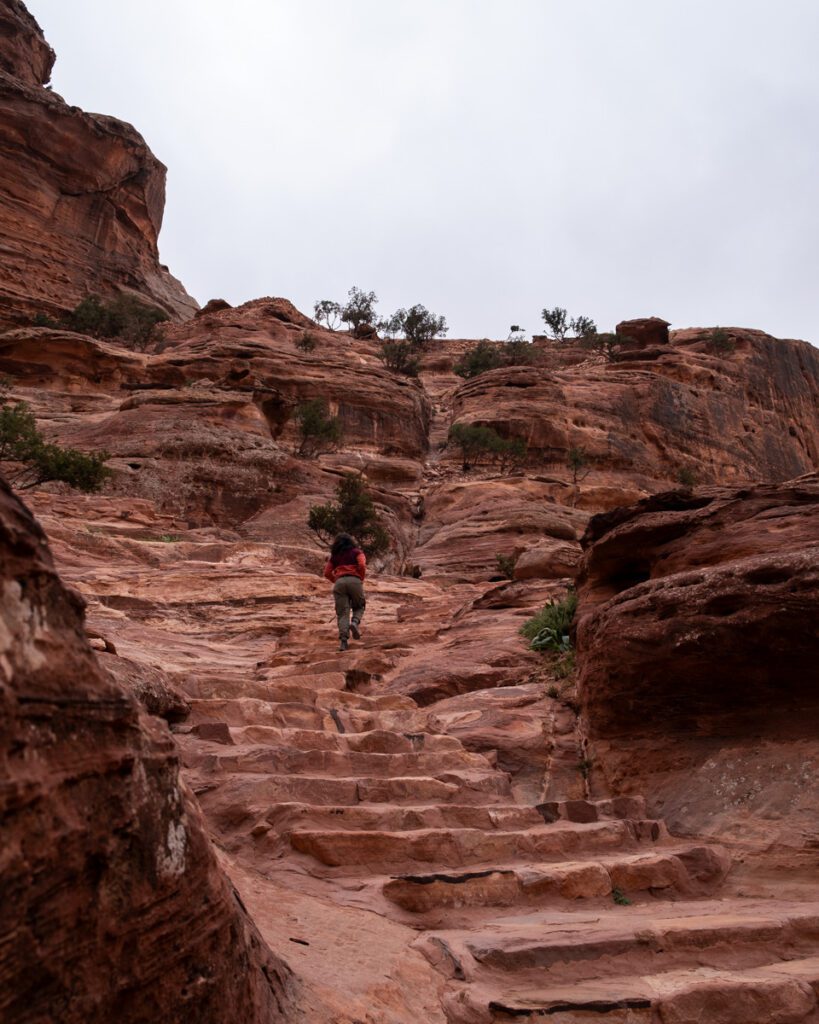
From there, you’ll walk up, down and around the mountains of the back part of Petra. The views are absolutely stunning. Mountains as far as you can see. You’ll even see Wadi Arabia in the distance.
The path from Little Petra to the Monastery will take about 1.5 to 2 hours, depending on your walking speed and how many times you stop for the views. As for the hike from the Monastery to the main section of Petra, it will take about 1 hour.
Once you’re back at the main part of Petra, you can walk back toward the main entrance, which will take another 3 hours. This is why we recommend doing this hike on your second day in Petra.
Doing this on your second day will allow you to see the parts of Petra you didn’t have a chance to see before. You’ll also be able to dig deeper into the attractions of Petra you enjoyed most on your first day.
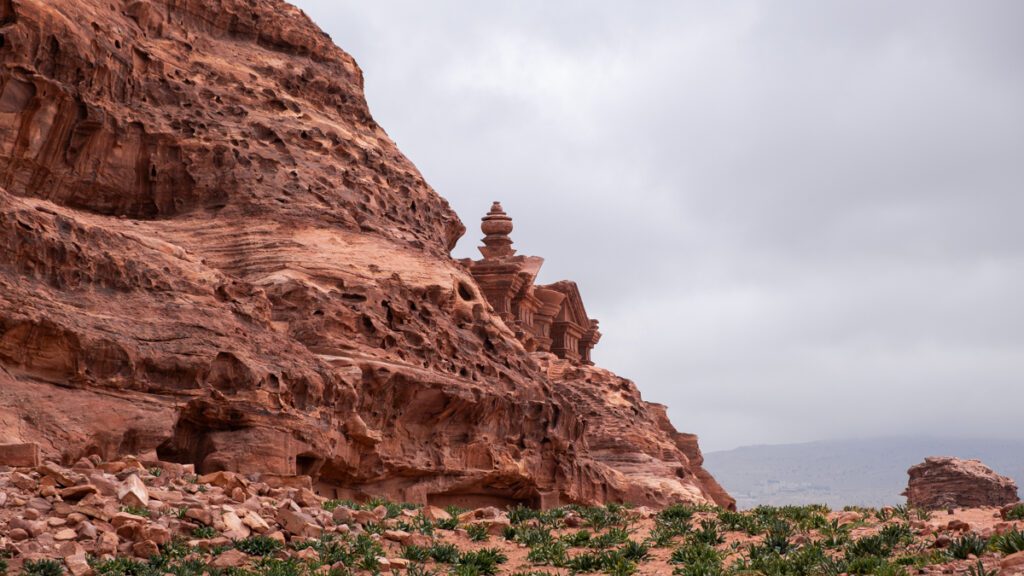
23. Petra by night, the most unique thing to do in Petra
One of the most unique things to do in Petra to experience Petra at night. This is when the main space is lit up with over 1,500 candles, all along the entire length of the Siq, up to the Treasury.
The event starts at 8:30 pm and ends at the Visitor Center at 10:30 pm. It takes place every Monday, Wednesday and Thursday. You’ll need to buy tickets in advance and plan your Jordan itinerary accordingly.
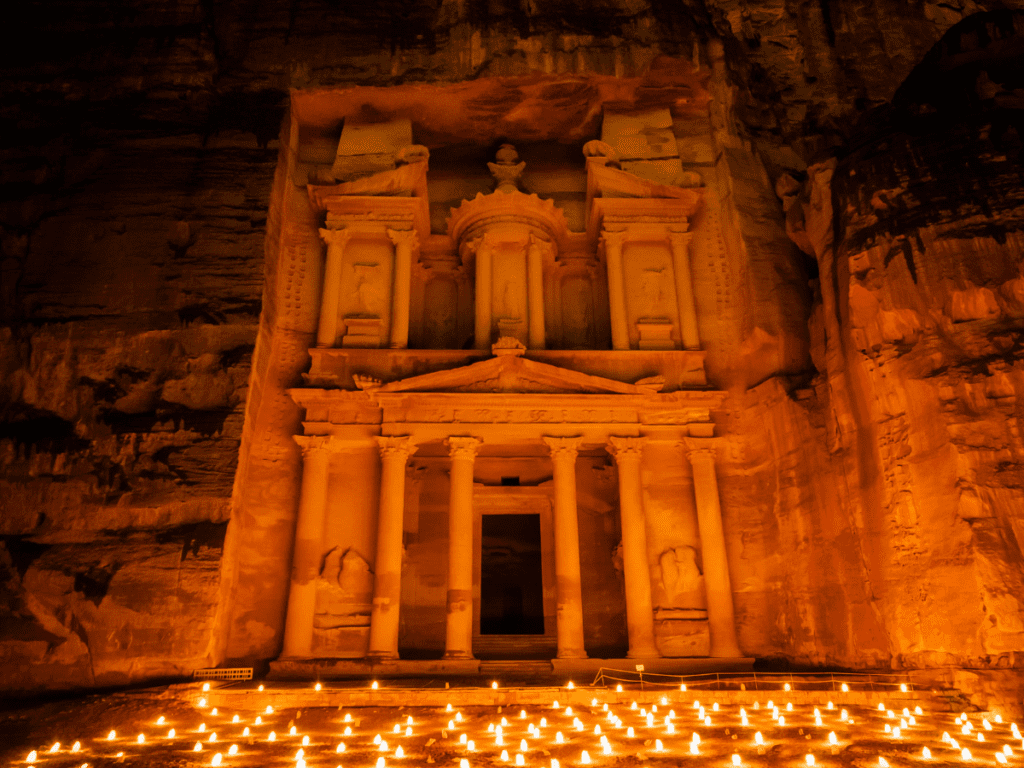
The entrance fee for Petra by Night is not included in your Jordan Pass or with your entrance tickets to Petra. It’s an additional 17 JOD per person, but free for children under 10. You can get your tickets at the Main gate of Petra, or from your Hotel reception.
We didn’t have a chance to experience Petra by Night. We’re not too mad about it – it was pouring rain every night we were in Petra. This was in mid-March.
We also read quite mixed reviews about the experience. Some people loved it, while others hated it. If you’re looking to experience it, we recommend you take a look and see if it fits within your budget, your interests and your itinerary.
Explore the Petra museums, one of the best things to do in Petra on rainy days
It’s true that being in Petra is like being in an open-air museum. And if you get unlucky with the weather like we did, you may want to take shelter and discover the actual museums of Petra.
There are 2 museums you can visit in Petra. The first one is the Petra Archaeological Museum, right before the visitor center. The second one is located in the Ancient City of Petra, by Qasr Al-Bint. The entrance to both museums is included in the price of your Jordan Pass or entry to Petra.
Here’s what you need to know about each of the museums.
24. Petra Archaeological Museum, what to do in Petra before entering the site
Right before getting to the Visitor Center, on the right side, you’ll find the Petra Archaeological Museum. It’s a free museum to visit and holds many treasures to discover.
Within this museum, you’ll find many Nabatean artifacts like pottery, coins, tools, and statues. You can also discover detailed models of Petra’s most famous structures, such as the Treasury and the Monastery. This is a great way to understand the architectural techniques and styles used by the Nabateans.
At the Petra Archaeological Museum, you can see more funerary art to learn about the different burail practices the Nabateans had. An important aspect considering many of the structures inside the walls of Petra are tombs.
Finally, you can also see some items like mosaics, glassware and Christian artifacts that come from the Byzantine church in the Ancient City of Petra. This will give you a glimpse into the significance of the Roman and Byzantine periods.
You’ll need about 1 to 2 hours to take in the artifacts at this museum. It’s not very big, and depending on how much reading you want to do, it can be a short visit.
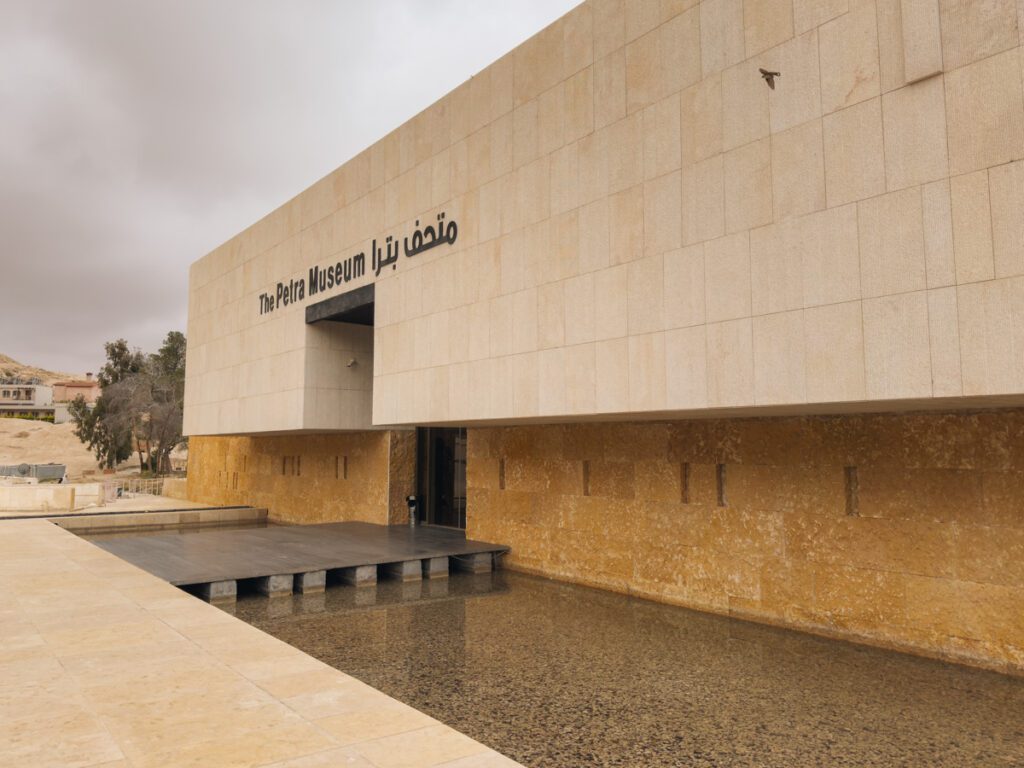
25. The Nabataean Museum, an interesting thing to do in Petra’s Ancient City
To visit this museum, you’ll need to go into the Ancient City of Petra, and walk the main trail all the way to Qasr al-Bint.
The exhibit in this museum is organized chronologically. You’ll be able to see interactive displays and artifacts that go through the history of Petra from prehistoric times, through the Nabatean period, and into the Byzantine and Islamic periods.
Some of the interactive features show digital reconstructions of Petra’s main structures with animations depicting ancient life in the city. You can also see an extensive collection of inscriptions in various languages, like Nabatean, Greek, and Latin.
Finally, the museum houses religious artifacts that give us a glimpse into the religious practices of the Nabateans, with statues of deities, altars, and ritual objects.
Again, you can spend a good hour here, learning more about what life was like for the civilizations that called Petra home, way back when.
In summary, the Petra Archaeological Museum and the Petra Nabataean Museum are essential stops for anyone interested in the rich history and cultural heritage of Petra. These museums offer a detailed and engaging look at the city’s past, enhancing the overall experience of visiting one of the world’s most remarkable archaeological sites.
The 25 best things to do in Petra
There you have it! All the best things to do in Petra, including the top attractions, the hidden gems and all the hiking trails you can trek. Don’t try to do all these things in one visit.
It will take a lifetime to uncover the full beauty and mystery of Petra. Take your time and see what interests you the most.
As a reminder, here are all the best things to do in Petra:
- Discover the Treasury
- Walk through the Siq
- Admire the Monastery
- Take a look at the Street of Facades
- Take in the Royal Tombs
- Enjoy the Amphitheater
- Discover the Djinn Blocks
- Check out the Colonnaded Street
- Admire the Great Temple
- Check out Qasr Al Bint
- Trek to Little Petra
- Climb to the High Place of Sacrifice
- Uncover the Garden Temple
- Admire the mosaics of the Byzantine Church
- Go to Aaron’s Tomb
- Take the Al-Khubta trail for amazing views
- Walk to the High Place of Sacrifice
- Take the Umm Al-Biyara trail
- Trek the Madras trail
- Go higher by walking the Jabal Haroun trail
- Walk the Sabra Trail
- Hike the backway
- Petra by Night
- Petra Archeological Museum
- The Nabataean Museum
Let us know in the comments which Petra attractions you’re most excited to see. Which of these is at the top of your list? Which hidden gem are you looking to discover? We’d love to hear from you.
Thank you so much for reading the article all the way through!
We put a lot of time and effort into the content we create. Please like, comment and share – every action on your part helps us out tremendously and is very appreciated.
You can also help us by pinning this article for others to find.
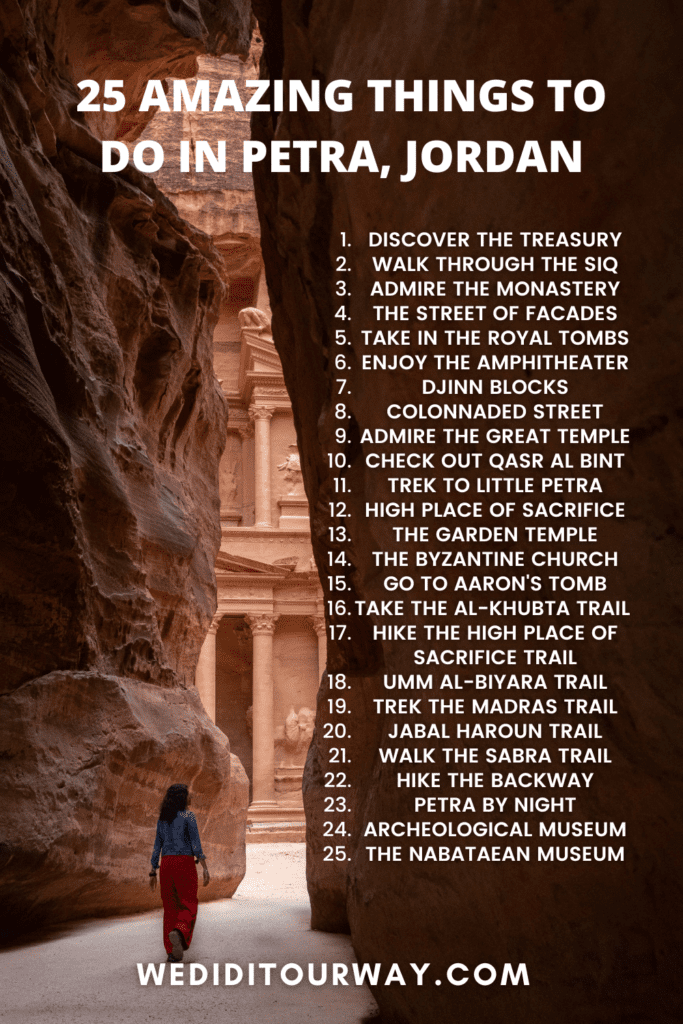
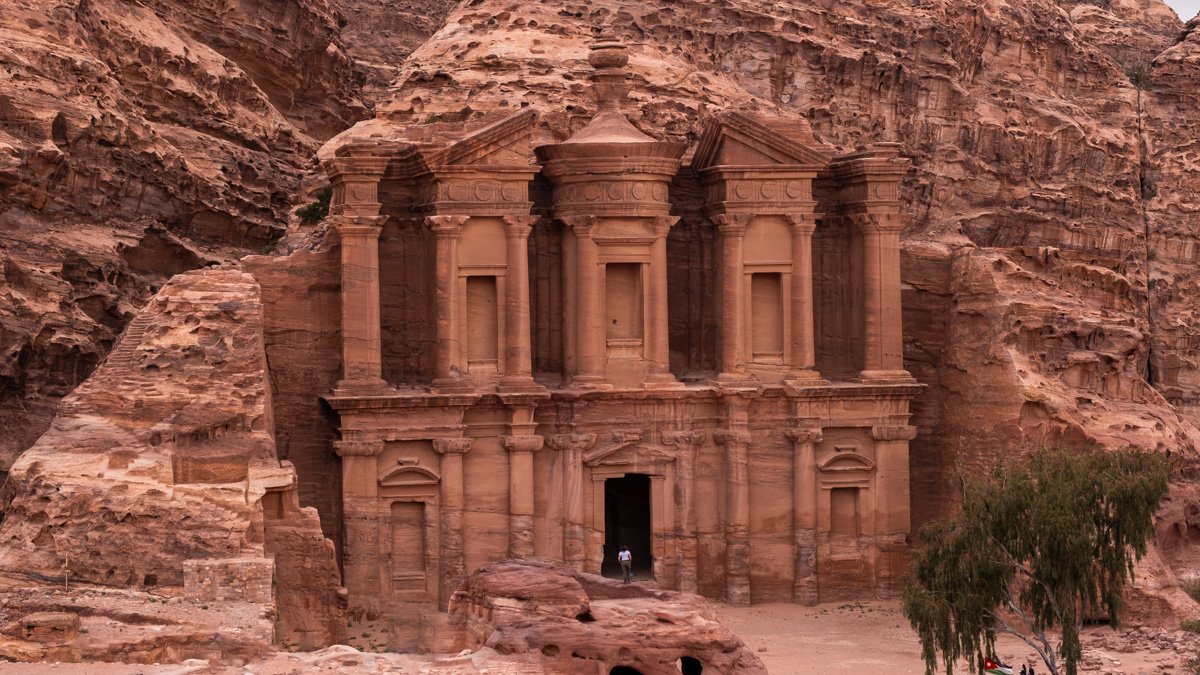

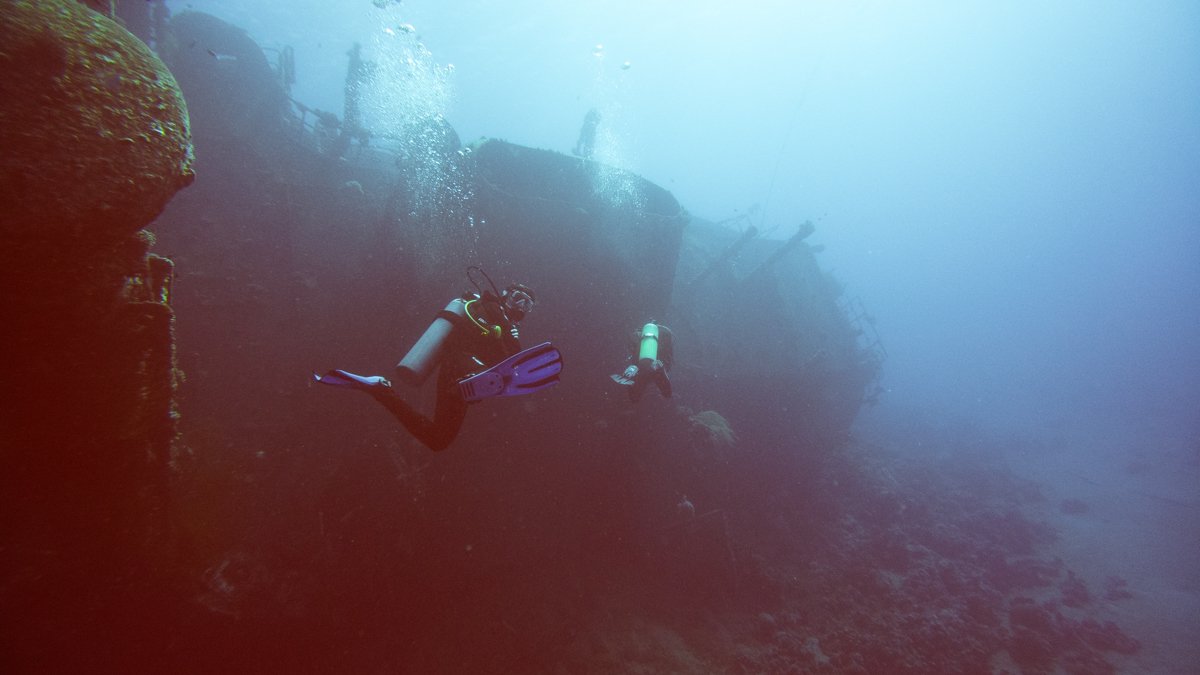
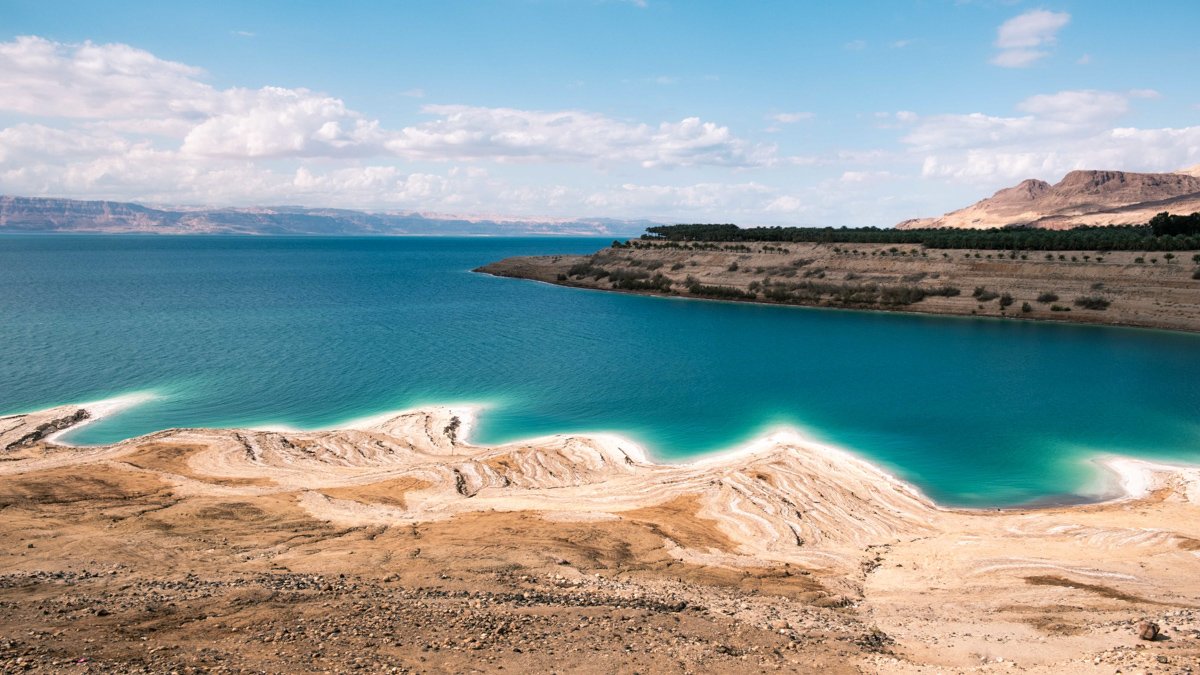
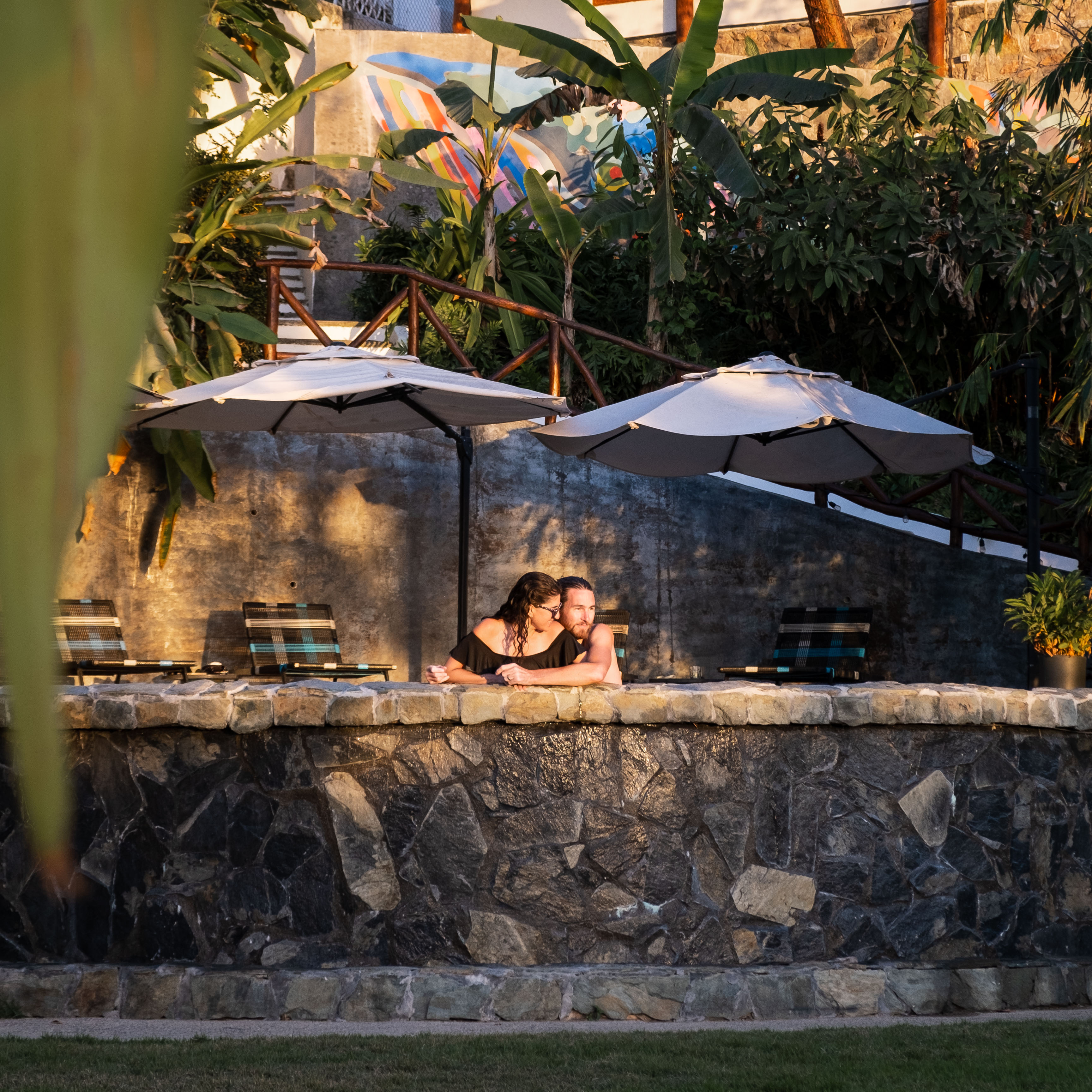


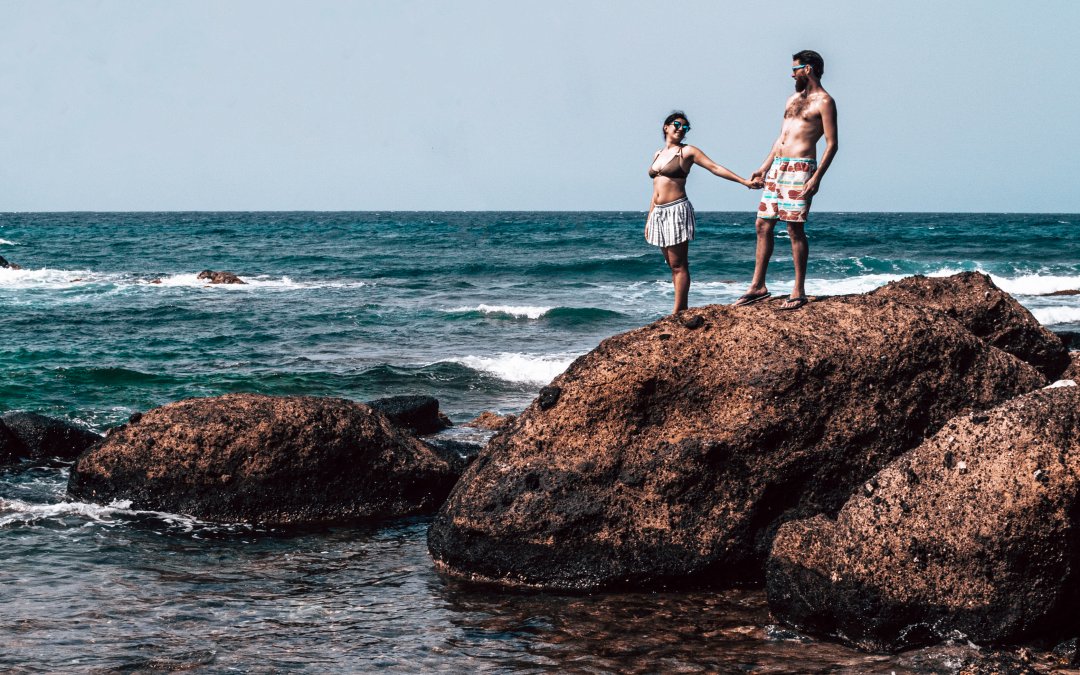
0 Comments